|
|
Post by codystarbuck on Dec 14, 2019 23:32:53 GMT -5
For the curious, about why I am not a shellback, despite crossing the Equator, here is the story.
I was a supply officer. That was a rare thing, as a regular Navy ensign. Midshipman from the NROTC program and the Naval Academy train to become regular "line officers." That means they train to one day command a naval vessel (even a pilot's ultimate goal is to command an aircraft carrier). Supply Corps is what's known as "restricted line;" it's embers may one day command their specialty's top commands;, but never a naval vessel. Restricted line are professional specialists: Medical Corps, Supply Corps, Judge Advocate General's Corps (doctors, supply officer, lawyers). In the Army and Air Force, supply is a job an officer may be assigned to, but will rarely spend their career in. The non-coms are their specialists. However, logistics at sea is a whole other artform. After commissioning, I spent 6 months at the US Navy Supply Corps School, in Athens, GA (now in Rhode Island), learning my trade. I then went to a frigate as the Assistant Supply Office (ASUPO). The Supply Department on a smaller vessel consists of 4 divisions: Stores, Mess, Disbursing, Ship's Service. The SUPO runs the Mess and Stores divisions, with usually a chief or senior chief as a second. The ASUPO runs Disbursing and Ship's Service, with a petty officer. On my ship, my 2 divisions consisted of 6 men, combined. I was also the Division Officer for the entire Supply Department, meaning I had administrative duties there, as well. I stood duty as Duty Supply, as well as Officer of the Deck when in port and for Sea & Anchor Detail (when leaving or returning to port, controlling access to and from the ship). I was also Helo Control Officer, coordinating the safe launch and recovery of out helicopter (used to hunt submarines).
Ship's Service provided barber and laundry services, as well as ran the Ship's Store, which acts as a convenience store for the ship. On my ship, it was the size of a Photomat booth, with candy and cigarettes, toiletries, limited supply of uniform trousers, as some entertainment items (cassettes or CDs) or luxury items (cameras and watches, mostly). Bigger ships carried more. We also maintained vending machines for the command, with the money going to the ship's welfare and recreation fund.
Disbursing was the ship's bank and paymaster. I paid the crew on payday (1st and 15th of the month), arranged savings allotments (transfer of pay to savings accounts), sold savings bonds, maintained cash deposits for safekeeping (not really done after my time, as ships used ATM's to dispense pay). The DO also makes payments for travel expenses and for things like re-enlistment bonuses, as well as collects money owed to the Navy (wage garnishments, overpayments, etc). As such, the Disbursing Officer is financially liable for the money he maintains in the safe of the disbursing office. I had to balance it each week and on payday.
Let me set the scene of the beginning of my naval career. I was 22 (just, as I had my 22nd birthday while attending Supply Corps School) when I reported aboard my first ship. My welcome aboard by the Executive Offer (2nd in command) was "I don't like Supply officers; I never met one that was worth a damn!" That was Day 1 and it set the tone for our relationship. He treated both myself and my boss, the Supply Officer, with open contempt and derision, an attitude carried forward by the Operations Officer (who had similar contempt for his fellow department heads). Every day was a string of cracks about Supply not pulling its weight or similar "jokes" My boss took it; my people took it, I took it.
The Officer's Mess was hardly what I had seen on my training cruises or was taught at school. The Department heads belittled one another and not in a joking fashion. The skipper was moody and could turn on someone ina heartbeat. He had no children and was married to an Air Force officer. He cared about personal awards and was swift to get rid of anything that stood in the way of getting them. The XO was hated by most of the crew and despised by most of the officers. He set a poor example for all and gave contradictory and capricious orders. It was a dysfunctional command, to say the least. The enlisted just tried to do their duties and stay out of the path; but, the ship was miserable.
About 6 months into my time on ship, I found a discrepancy in my safe total, while balancing it. I recounted it and then audited my cash book for mathematical errors. I was still short about $250. I checked over payments I mad to my disbursing clerk, to reimburse his funds. I couldn't find the source of the deficiency. I told my boss about the problem and asked him to look at things. He couldn't find it. Knowing that I was financially liable, I had him witness me make payment for the missing funds from my own pocket. He then reported the situation to the captain. Rather than make my boss babysit me closely, until I demonstrated I could carry out my duties without issues, as was the case with some of my fellow junior officers, I was relieved of my duties and he sent in a formal request for Relief For Cause and recommended my expulsion from the Navy. We were barely 3 weeks into a 6 month deployment and I was transferred to the parent Destroyer Command, pending disposition of my case, and was sent back home. However, I did not depart the ship until we reached a port, in Brazil, a week or two later.
During my time without financial duties (though I still had collateral duties and watchstanding) we were set to do our Equatorial crossing. I made a decision that I would not partake in the hazing. The whole thing seemed juvenile to me, on the surface; but it was my act of rebellion against a skipper and command who I felt treated me unfairly. Things began early in the morning, with the rousing and rounding up of the Pollywogs. They banged on our door and my roommate got going for his humiliation. I told them I refused to take part, as was my right. The "ceremony" was strictly "voluntary," though like most hazing, participation is HIGHLY encouraged. I stood my ground and was told that I had to at least go to the wardroom or work. I had no workk duties, so I went and hung out in the sick bay, with the ship's corpsman, who was busy sewing up and injury to a crew member, who was chased into a door frame. Not the frame of what you might see in your house; but, a watertight door, with a metal lip around which "dogs" lock into place to seal it and prevent water from passing through. I snuck above deck and watched the "festivities" for a few minutes, before I was ordered below by the captain. Everyone was made to crawl on hands and knees, through muck, each "food" that was filled with fish oil, pepper, peanut butter, tuna, and other nauseating things. They were put ins stocks, then made to pull a rubber dildo out of a toilet bowl, with their mouth. They then crawled to the Royal Court, where they kissed their feet and had their face smeared into the belly of the Royal Baby (which was covered in goop). They then moved on to finish at a dunking tank.
About a month before we left, there was a news story of a sailor who suffered a ruptured stomach, after being made to do endless sit-ups, after ingesting noxious food, during that ship's initiation. The sailor died. Warning were sent out to commands that any such instances of things getting out of hand would face disciplinary action. We had two injuries on my ship; the aforementioned sailor and the door, and another who twisted an ankle on the focsul, when the ship suddenly changed course.
I flew home when we hit port and went to work at the Destroyer Squadron Command staff, while my case was decided above. I went to work in the material office, helping track vital repairs to ships, locating repair parts and expediting shipment, plus other duties. My weight ballooned with the stress of my time on ship and while waiting to hear my fate. I could be discharged from the Navy and have to pay back my scholarship. The determination came down that I was Relieved for Cause, but no punitive action was recommended. I could be reassigned or I could resign my commission, if I chose. I chose to stay and finish my committment, but had to drop weight before I could be reassigned. I got my weight down, eventually and impressed the Commodore in charge of the Squadron with my determination. He lit a fire under my detailers (people who assign jobs) and they came back with a temporary assignment, on a ship, as a test. I spent 6 months on that ship, running the officers and chiefs messes and assisting the Supply Department. However, it became clear to me that I wasn't going to get a second chance. At the end of the assignment, I put in to resign my commission, at the end of my 4 year commitment. The request was granted. I went back to the Squadron to finish out my last 6 months, doing the work I had been doing there.
The Chief Staff Officer of the Squadron later confided in me that I got a raw deal. They had been put in a position where they had to uphold the captain's authority, but wrote their endorsement in a way that said they disagreed with the decision (but wouldn't overrule it) and ensured that no action was taken against me. I thanked him for his honesty; but replied it would have been nice if someone had advised me that they had no case for their actions and that I could have fought them and gotten a potential dismissal of the Relief. The XO of the temporary assignment ship said similar things, that he felt I got a bad deal and that he had a similar situation with an assistant supply officer, and he made the supply officer mother hen him until he improved in his performance. He said he finished fine, but I wasn't given the chance and he agreed with me that the Navy wasn't likely to ever give me a real second chance.
So, that is why I am not a Shellback; an act of defiance to a command I felt wronged me. On the one hand, I removed myself from the company of my shipmates by not participating in their group activity. On the other, I stood my ground against a juvenile hazing ritual designed to relieve boredom and celebrating the fact that we crossed an imaginary line on a map. I stood alone, which I think earned the respect of some. I was already being publicly humiliated, so why participate in further such things?
That was all in the past and I don't expect or request sympathy for it. I made mistakes and paid for them and made decisions and lived with them. I knew from my first midshipman training cruise that I was not going to make the Navy a career. Quite frankly, I hated life at sea and that first cruise convinced me to get out after my 4 years. However, I was bound and determined I would do it on my terms and not the whims of a vindictive skipper or his poor excuse for a leader XO. I learned a lot in my four years that stood me well, especially about leadership. I have been in a supervisory capacity in all of my civilian jobs. I always treated my subordinates with respect and fairness and never asked them to do anything I didn't or couldn't do. I tried to mirror the example I wanted set for them in doing their jobs. I learned it the wrong way, with bad examples; but tried to pass it on with good ones.
I always wondered what Sam would think of that. Officers feature very little in his stories and I suspect he had little use for most of them. The enlisted do the real work and the noncoms do the real leading. Sam served in wartime, in a war that counted. I served in a time where we went looking for wars, to escape the stigma of Vietnam, fuel the Defense Machine, and for political points. I like to think Sam would understand more than most.
|
|
|
|
Post by codystarbuck on Dec 19, 2019 17:07:40 GMT -5
Unknown Worlds of Science Fiction #2 Wonder where they got that idea.....  Creative Teams: Creative Teams: War Toy-Tony Isabella & George Perez; Adam & No Eve-Denny O'Neil & Frank Robbins; Hunter & Hunted-Mike Kaluta; Specimen-Bruce Jones, Triffids-Gerry Conway & Rico Rival; Roy Thomas-edits Interview with Alfred Bester (by Denny O'Neil) and a piece from Don Thompson about early sci-fi fandom. Harlan Ellison's Repent Harlequin is absent. Family issues with Alex Nino delayed the piece. Roy promises it for next issue. Synopsis: The Slow Glass linking device reappears. War Toy-I covered this with Marvel Preview #20, where it was reprinted. Military robot as an allegory of the soldiers of Vietnam. Not exactly The Forever War. Artwork is early, rough Perez... 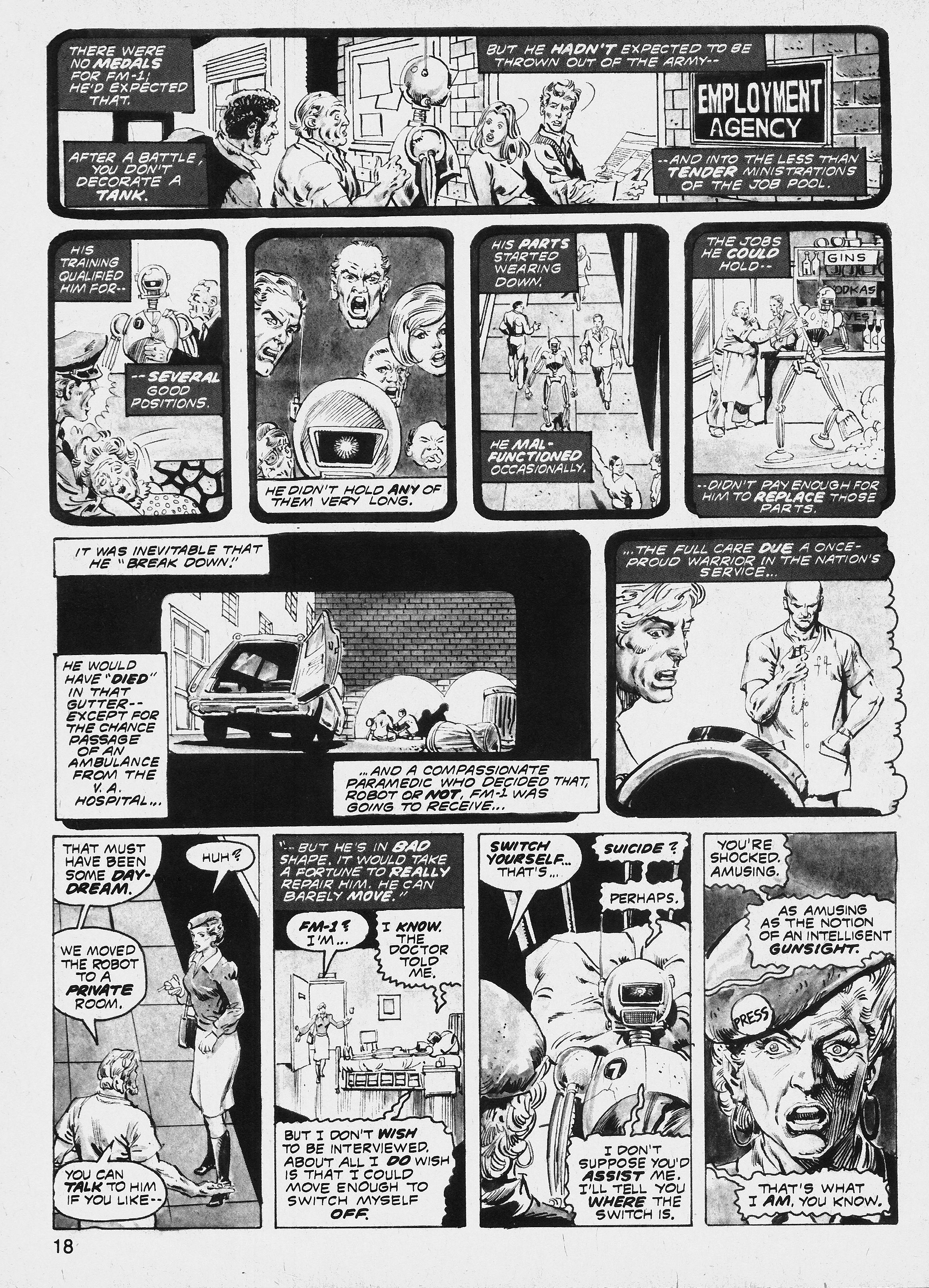 Adam & No Eve-A scientist creates a rocket to the stars; but, is warned that the fuel could set off a chainreaction killing all life on the planet... 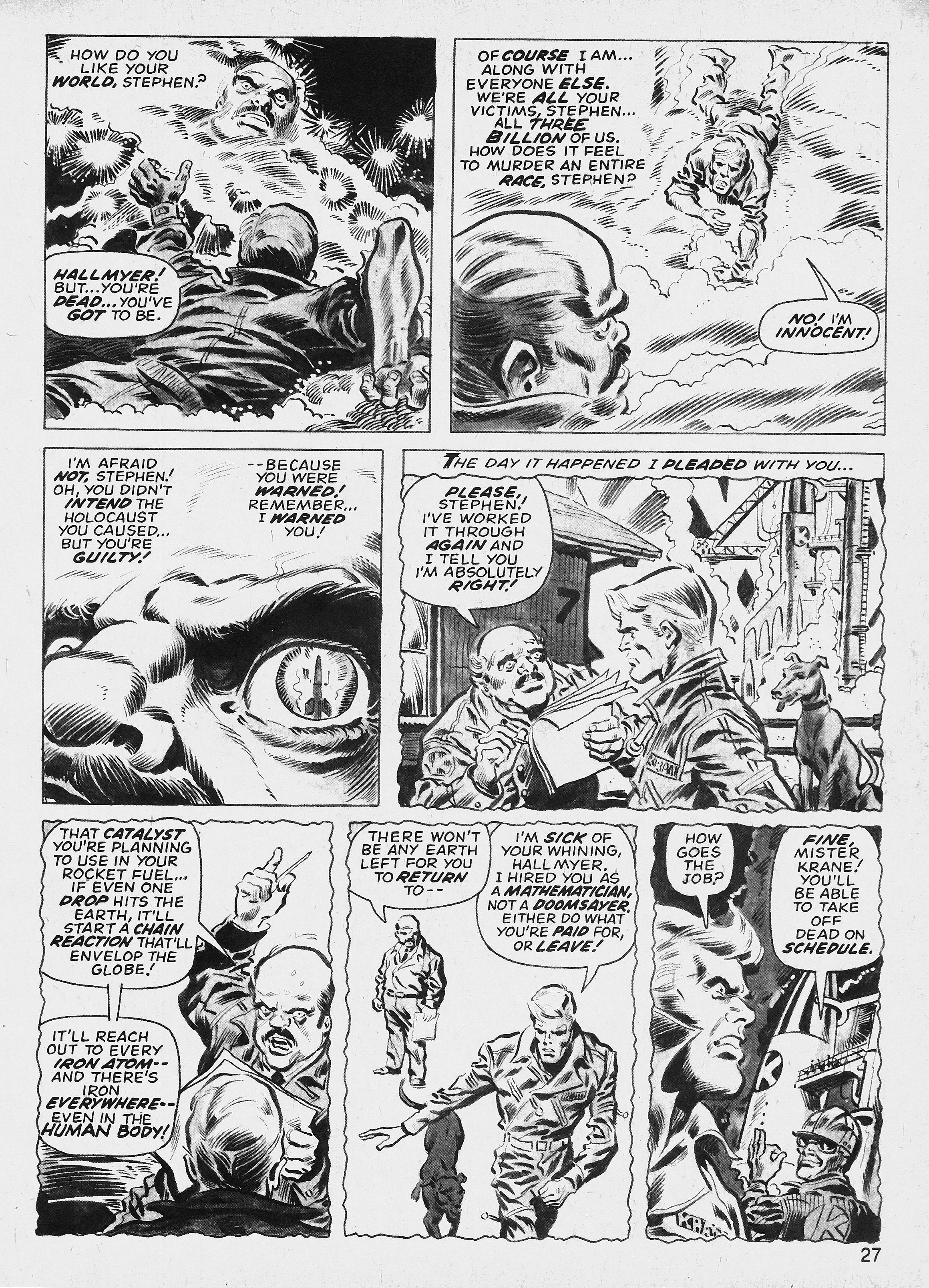 He ignores the warning and presses on. Attempts to stop him fail and he launches and just what was predicted occurs. He parachutes back to Earth and breaks his leg and ends up the last living creature on a desolate Earth. Hunter & Hunted-Um, some kid is outside a spaceship, or something, pointing a raygun inside.... 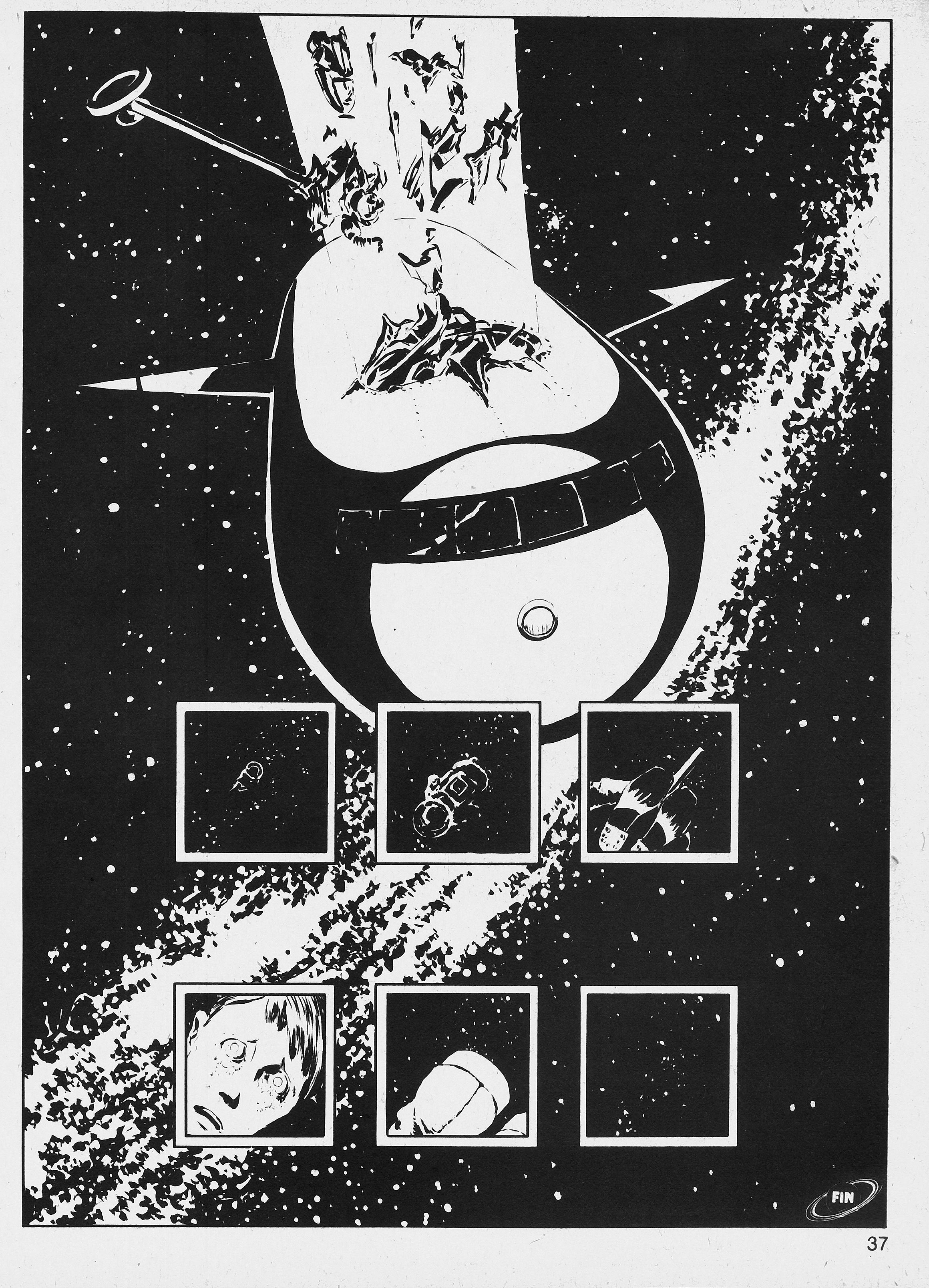 Pretty trippy weirdness. Specimen-A spaceman named Rad has landed on a planet after detecting an antiquated SOS. There had been a war, so he is wary. he finds a naked chick bathing in a stream. He takes her prisoner on his ship. The ship is automated and she tries to make friends, but, he keeps citing rules... 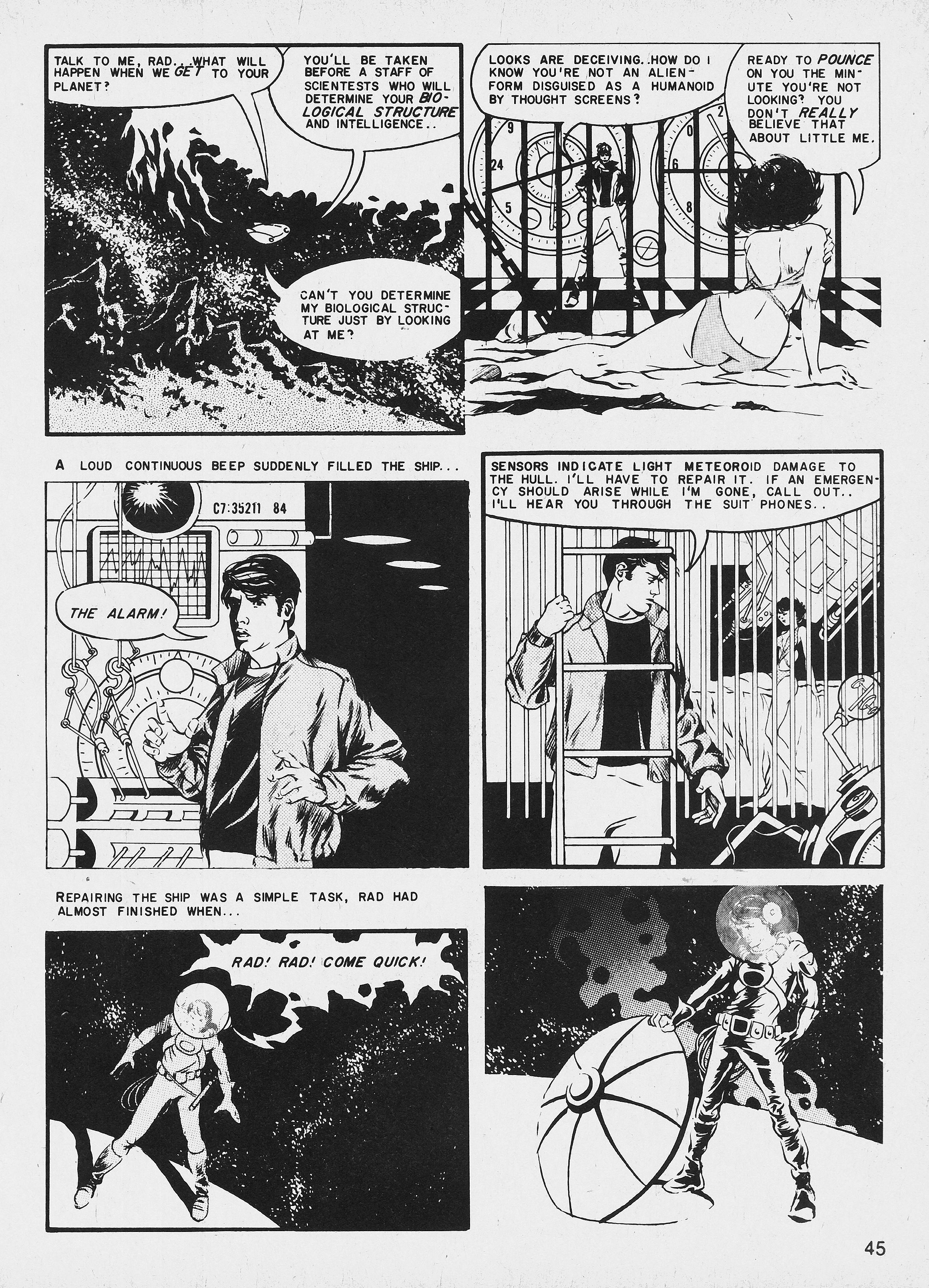 He has a computer make her a garment, which is see through and he gets horney enough to give in and open her cell, with bad results; but, not what you expect. Triffids-Bill and Josella are separated and Bill ends up the prisoner of a blind group, forced to be their eyes to find food. He encounters others and discovers a plague is spreading. It kills his group and he escapes. He finds a little sighted girl and takes her in and heads for Sussex Downs, hoping to find Josella. HAlong the way, he meets a devout Christian woman who shelted the blind people. He eventually finds Joeslla, on a farm. They reinforce the place against the Triffids... 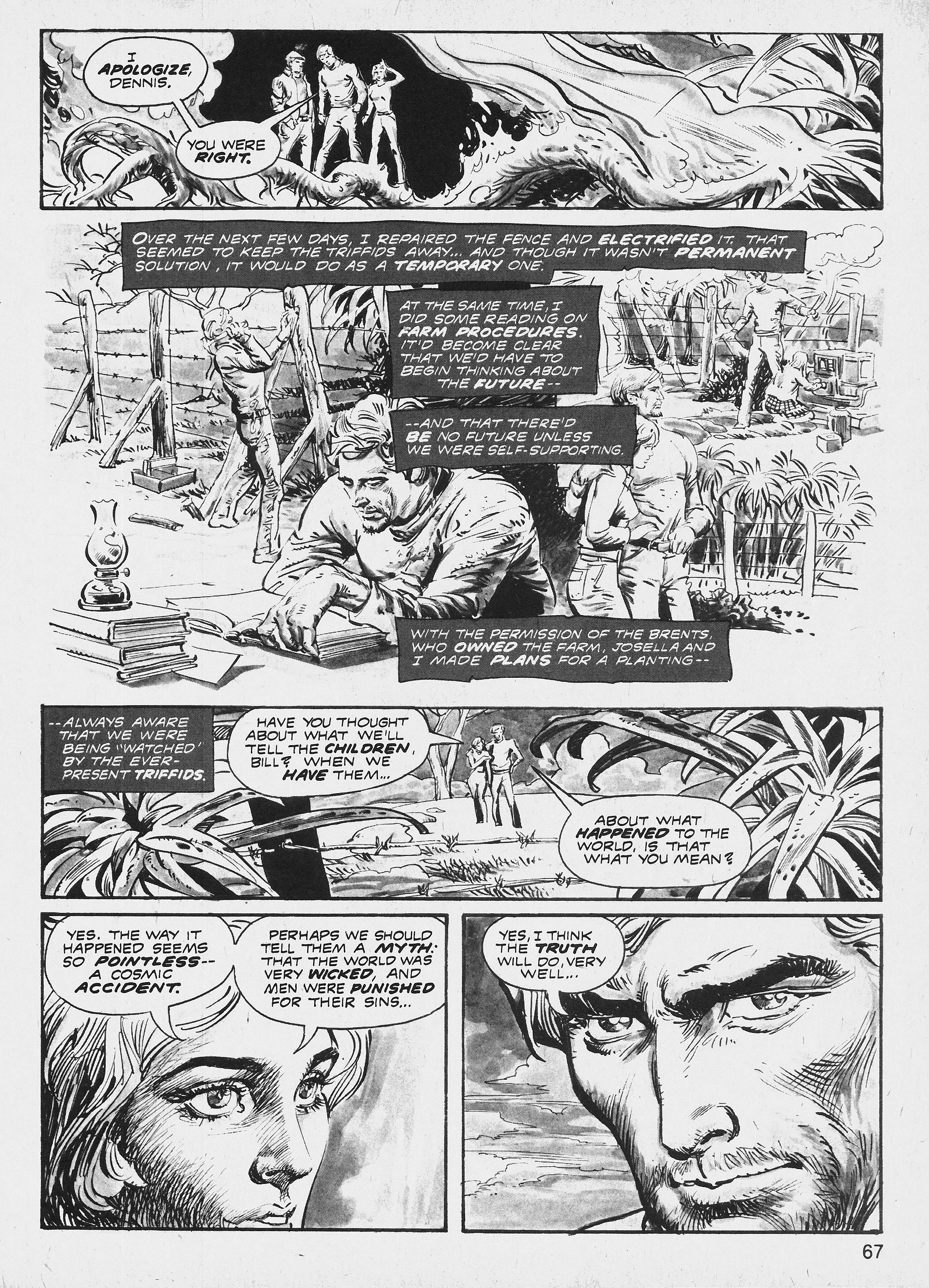 Eventually, the meet some others, with a haven on the Isle of Wight and continue to survive. Thoughts: So-so stories. War Toy is a bit ham fisted and not particularly deep. The art is fine; but doesn't really suggest the Perez to come. The Kaluta piece is out there. Adam & No Eve is adapting a Bester story. The premise is a bit far fetched and it comes across a bit sleight here. The Bruce Jones thing is typical of his work; EC-inspired and similar to stuff he did at Warren and Pacific/Eclipse. Triffids is okay; not much on a visual standpoint; I've never read it or seen the movie, so i don't know how it compares. It reads a bit melodramatic, which is the norm, for comics. All in all, this is fine; but hardly groundbreaking or compelling. EC and Warren had better stories. However, we are promised Ellison, again, for the next issue. Alfred Bester produced two sci-fi classics: The Stars My Destination and The Demolished Man. the first is a sci-fi reworking of The Count of Monte Cristo and was adapted by Howard Chaykin, for Byron preiss. The latter would make for a good comic, as it features a psychic detective in a world where murder is impossible, yet occured. The book was a major influence on the creation of the Psi-Corps, in Babylon 5 and Joe Staczynski named the Psi-Cop Bester, after the author. So far, I think Roy's ambitions outstretch his budget and the available talent.
|
|
|
|
Post by codystarbuck on Dec 19, 2019 18:55:23 GMT -5
Marvel Graphic Novel #31, Wolfpack Creative Team: Creative Team: Larry Hama-writer, Ron Wilson-pencils, Whilce Portacio & Kyle Baker-inks, Joe Rosen-letters, Petra Scotese, Christie Scheele, and Glynis Oliver-colors; Ann Nocenti-edits Synopsis: In the South Bronx, we meet a group of ethnically and physically disparate youths: Rafael, a Puerto Rican with some martial arts training, Slag, an African-American who reads Shakespeare and fights like a pro, Slippery Sam, who presents a facade of studious nerd at school, and New Wave hipster outside; and Wheels, a disabled youth. They attend the same high school, where Rafael is accosted by a gang of African-Americans and pushed into a fight, because he has advised people not to pay them protection. He stumbles into Slag, who ends up rescuing him, as the Dean comes along,. Sam rats out the gang and leaves with Rafael. They later meet up with Wheels. Rafael works at Sam's father's hardware store. they go there and find Sam's father injured, as three masked people smashed up the place. Rafael knows it was the gang. 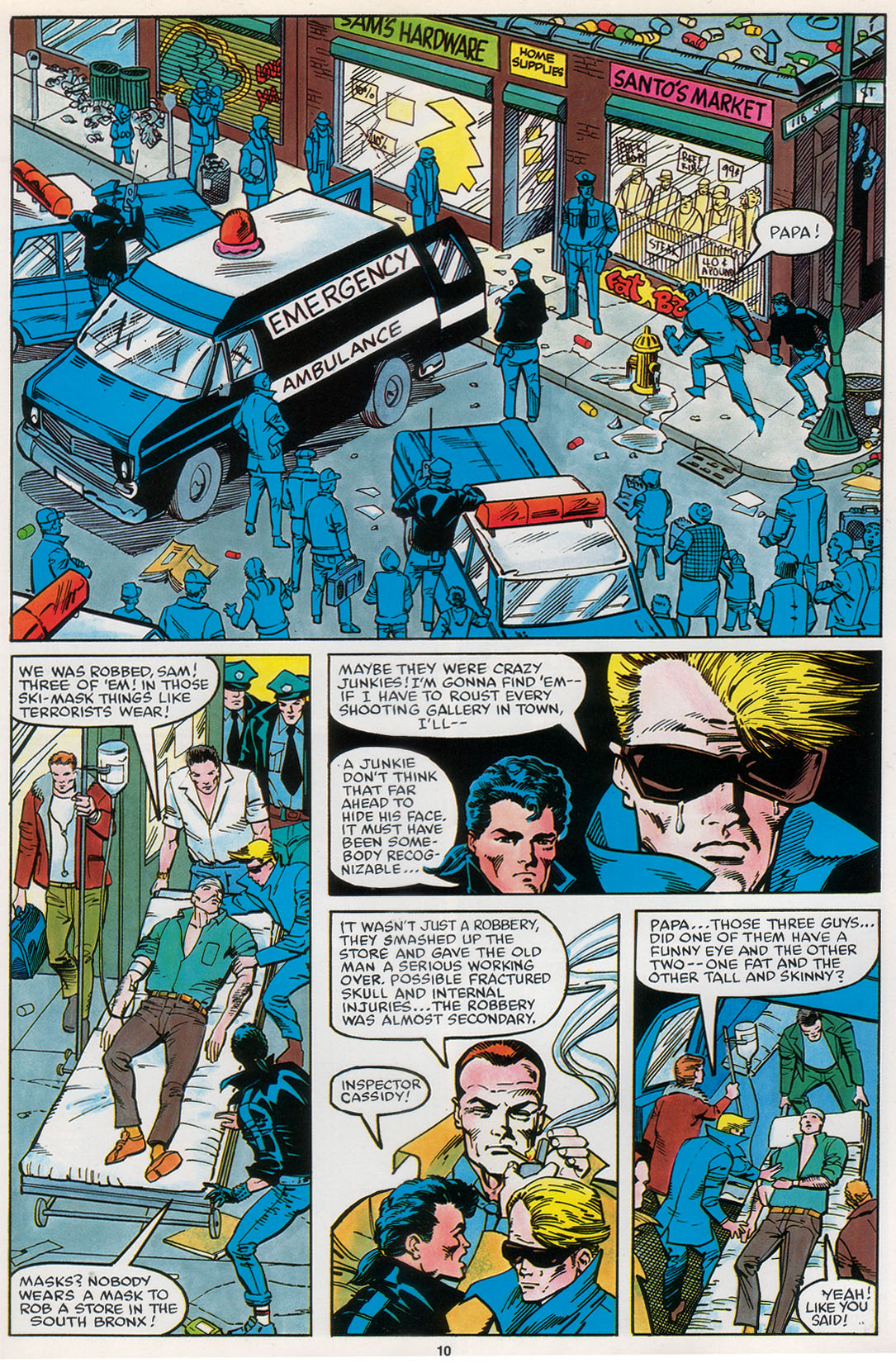 Rafael sneaks out to meet Mack, an old African-American man who served in the gunboat navy, before WW2, in China. He is rescued by an old Chinese woman when a group of racist sailors attacks him. She trains him in ways more ancient than the Shaolin or the samurai. He is taught to be ready to fight The Nine. 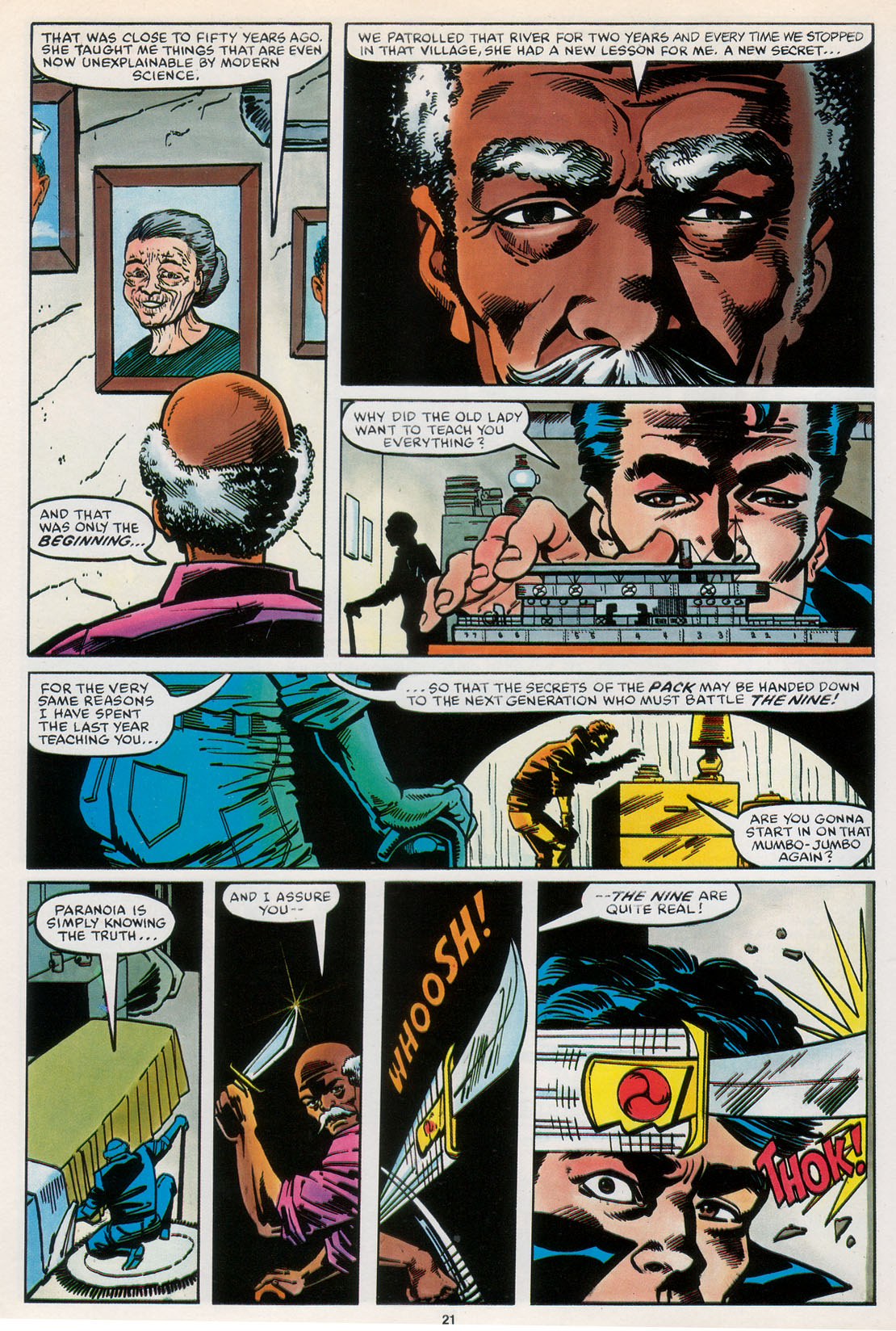 He is then introduced to Mack's other students, including Slag, Wheels, and Sharon, a girl who works at a burger joint that Rafael and Sam went to earlier (Rafael is attracted to her). Sharon tells of a lost Hebrew tribe who speak of Ten just men, who are opposed, cosmically, by 9 evil and corrupt. They realize the only way to defeat the Nine, is for one of the Ten to break off and create a new faction, who live like a pack of wolves. Rafael is skeptical and they find Sam and the police at the store, where Lamar, of the gang, is being taken off in an ambulance. Sam says he knows Lamar was partof the gang ho sashed the store and that he tried to torch it. Lamar denies it and a lawyer turns up to represent him, who wears a signet ring of the Nine. Sammy is arrested for assault and is attacked in jail; but, he is nother student of Mack's. Two little girls are run down by a drunk driver and Sharon & Rafael chase him down. Lamar is taken to be inducted into the service of the Nine. Lamarr aids assassins in getting to Mack. The pack goes hunting and attack te Nine and their agents. Lamarr ultimately pays the price. The Pack remain together to protect the Bronx from the Nine. Thoughts: This thing reads like a mini-series cobbled together for a graphic novel. A 12 issue limited series would follow. Hama attempts to do an urban vigilante story, mixed with martial arts and ninja, and Talbot Mundy and Theosophy. Theosophy was a religious movement in the early 20th Century, largely founded by Russian immigrant Helene Blavatsky. It mixed esoterism with religious teachings, including kabbalistic elements. it spoke of The Masters, guardians of ancient knowledge. Talbot Mundy was a pulp writer, one of the kings of the early adventure pulps who wrote such things as King of the Khyber Rifles, and the Jimgrim series, about a desert adventurer that is one of the prototypes for REH's El Borak and Indiana Jones. He was a Christian Scientist, who later fell in with the theosophists and filled his stories with secret brotherhoods and ancient wisdom. One of his novels was The Nine Unknown. It tells the story of a secret brother hood of nine men, who gard the ancient secrets, lest they fall into the wrong hands. they face off against 9 worshippers of Kali, ho create confusion and sow discontent and chaos. Here, The Nine are the chaos agents and The Ten are The Masters and The Nine Unknown, the guardians who fight for humanity. The Wolfpack are learning to become the new Masters. The early portion, about Mack's discovery of the secrets, in China, is partially inspired by The Sand Pebbles, which tells of a Navy Gunboat in 1920s China. The work is filled with racial tension, while presenting a mixed race group, showing that the Ten came from various cultures. It is the foundation of a good story; but, Larry Hama isn't really the writer to turn it into something exciting. I'm kind of surprised this was even published, asit isn't that commercial, though we do see a lot of urban vigilante comics, at this time (1987). The story is a bit convoluted, with so many characters and Ron Wilson's art never rises above average mid-level Marvel. I suspect Hama's friendship with Shooter got this greenlit when others would have had a harder sell; though, who knows? Marvel was flooding the stands to drive out independents (as was DC) and a lot of material got out there that went against commercial ideas. This would have been a better project for someone like John Ostrander and Tim Truman, who knew how to do urban stories and mysteries. Also, Ostrander was great with characters. Hama is trying here; but, it doesn't seem to be within his talent to make this rise above the average. He gets points for being different, though.
|
|
|
|
Post by codystarbuck on Dec 22, 2019 17:41:58 GMT -5
Unknown Worlds of Science Fiction #3 Creative Teams: Creative Teams: Occupation Force-Gerry Conway, George Perez & Klaus Janson (from Frank Herbert); Not Long Before the End-Doug Moench & Vicente Alcazar (from Larry Niven); Gestation-Bruce Jones; Repent Harlequin-Roy Thomas & Alex Nino (from Harlan Ellison); Roy Thomas-edits. Synopsis: Roy walks back his statement in the previous issue that space opera had run its course, saying he meant Buck Rogers and Flash Gordon and Tom Corbett; westerns transplanted to space, not stuff like Star Trek (which had as much in common with space opera as hard sci-fi). He's gonna be walking that back some more when Space Opera returns with a vengeance, thanks to Star Wars, which will revive both Buck Rogers and Flash Gordon. Didn't do much for Tom Corbett, Rocky Jones or Captain Video, though. Did give some life back to EE Smith and Edmund Hamilton. More of the borrowing framing device that is slow glass. This time, an alien comes to the Greenwich Village shop and sees a future. Occupation Force-An astronomer observes an object come from the belt of Orion to our system, at 1/3 light speed (illustrating that Marvel doesn't understand light speed). It's an egg-shaped ship, which orbits the Earth and sends a scout, which grabs a guy. The military want to nuke it and Gerald Ford isn't quite ready for that, when another scout lands on the White House lawn. Ford, Kissinger and the rest go to see what's up (I assume Gerry trips on the steps to the lawn). Out come some aliens who look like Victorian diplomats, in top hats and the president is tld that these aliens colonized the earth 7, 000 Years ao and are back to check up on the colony. 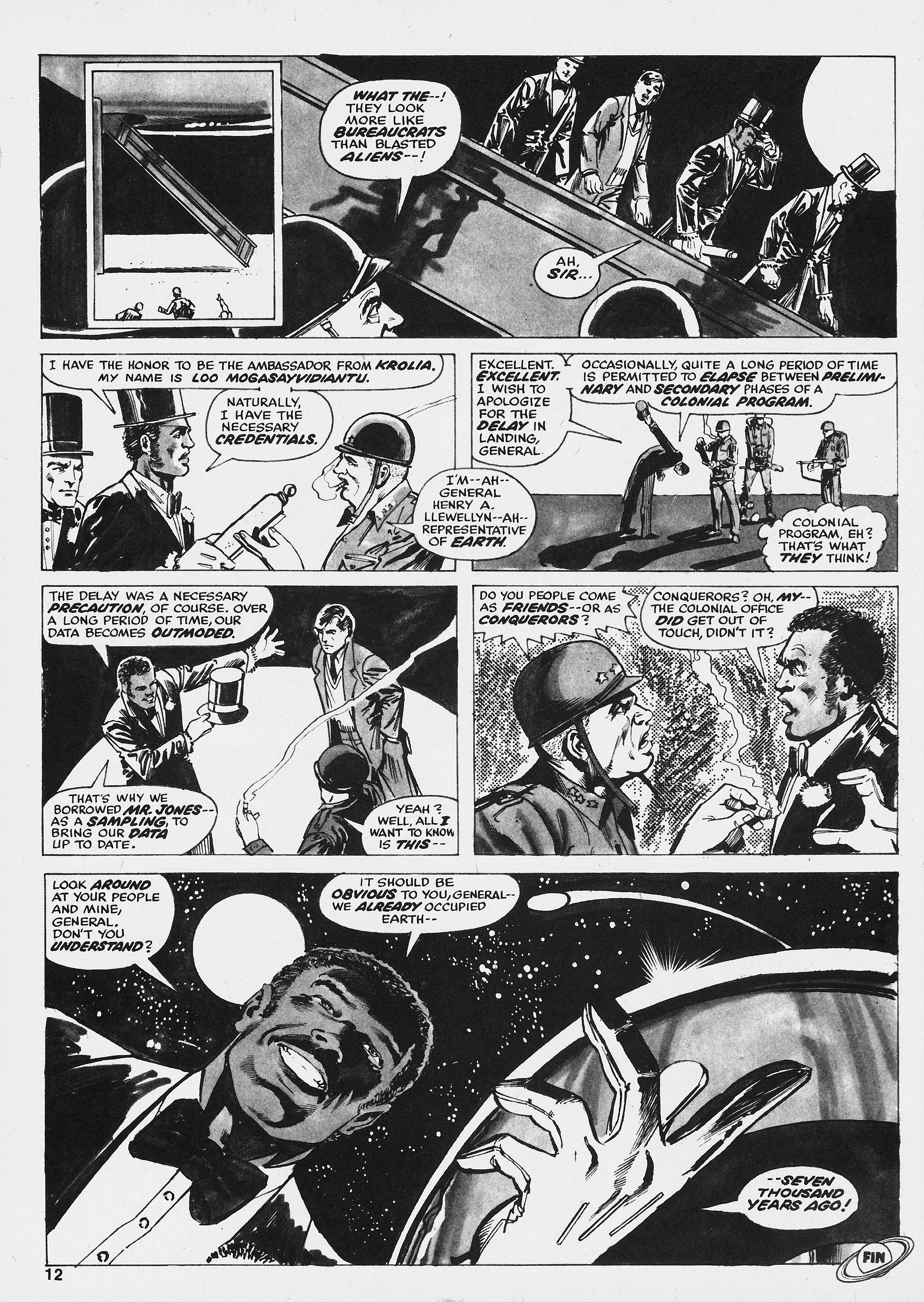 Not Long Before the End-Magician discovers magic fades when he stays in one place to long; barbarian tries to kill him, turns out magic is derived from mana, a finite resource. it dries up. Allegory for oil and carbon resources, Gestation-A scientific exploration lands on a tropical planet and explores; they get bit by insects, start acting weird, spin cocoons, emerge as naked butterfly people. Repent Harlequin-an ordered society finds itself disrupted by a harlequin, who brings anarchy to its world and is hunted down. he upsets the class structure, he interrupts productivity, he brings identity. 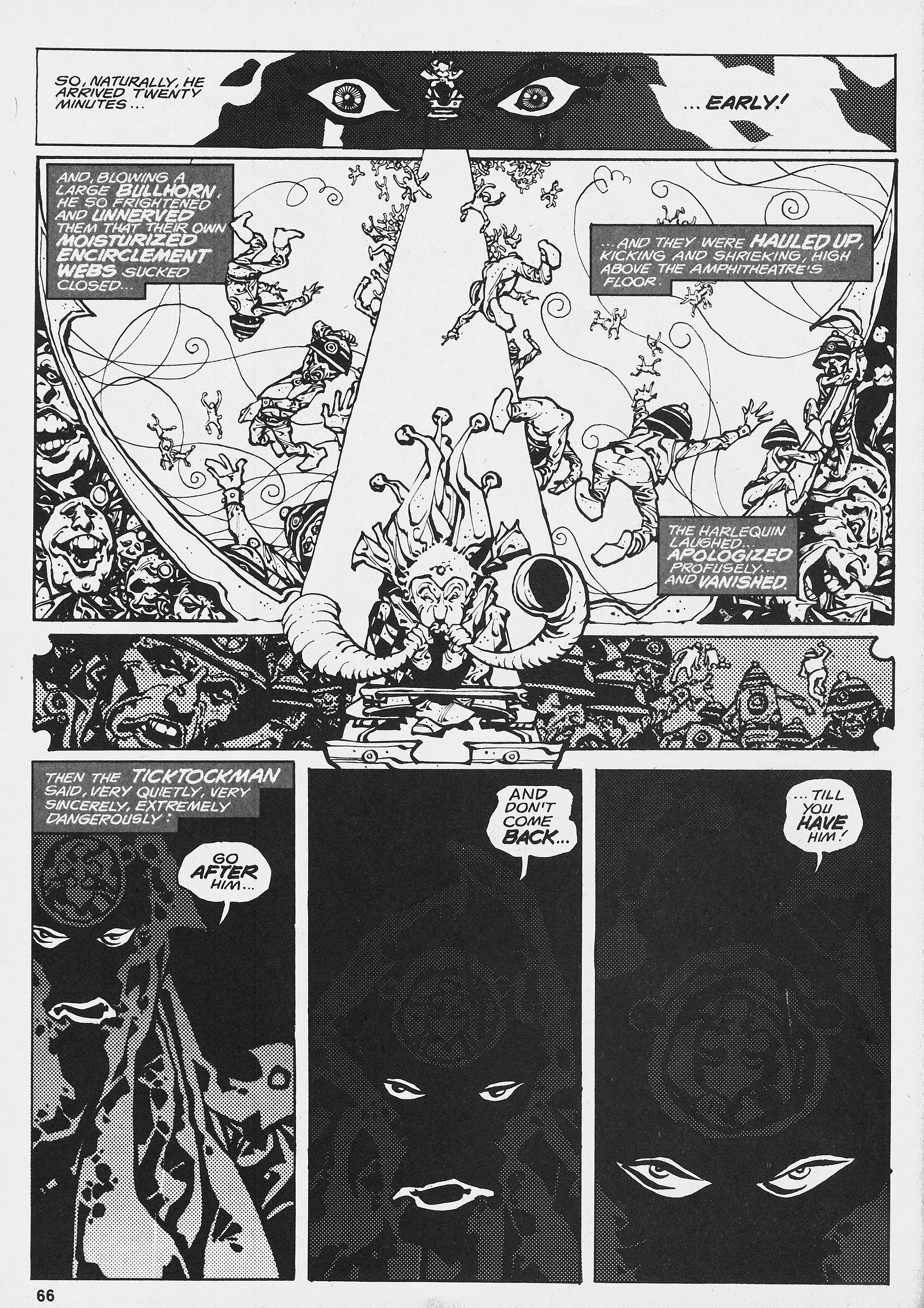 He is caught and rainwashed; but, his impact shines through, as the ticktockman is late. Thoughts: Aside from an interview with Frank Herbert and a piece about the Science Fiction Writers of America and the Nebula award, the only piece really worth reading is this adaptation of Harlan Ellison's Repent Harlequin..., with Alex Nino's fantastic art. It captures the spirit of rebellion and nonconformity that Ellison infused within it, taking up the lines of Henry david Thoreau's Civil Disobedience. He shows how society's kill creativity in the drive for order, as art often comes out of chaos. It was a call to think for oneself and be willing to stand against society when it is wrong. The imagery within have influenced numerous works, including Denny O'Neil & Jim Aparo's Prankster (Peter Cannon..Thunderbolt #60), Matt Wagner's Grendel (the Eppie Thatcher Grendel), and characters like Ambush Bug. Gestation is pretty cliched shock sci-fi, with naked women thrown in, as Jones tries to do EC stuff, again. Occupation Force is slight, predictable, and reminds one of So Beautiful, So Dangerous, from Angus McKie, which ran through Heavy Metal (and was in the film), though the idea is also in The Day The Earth Stood Still. Not Long Before the End was the first of Larry Niven's Warlock stories which are fantasy stories about magic being a finite resource and disappearing, as an allegory to the energy crisis of the mid-70s. The pinnacle of this series of stories is probably the novella The Magic Goes Away, which was adapted by DC, in their sci-fi graphic novel line, with story & art by Paul Kupperberg and Jan Duursema. This version is rather convoluted; the latter handles the material in a better form. Already, we see the weakness in this series and why it was doomed to failure. At best, we get one good story and some mediocre ones and some middling adaptations. Alex Nino does great work and repent Harlequin is a high point. Bruce Jones is trying to do EC, by way of Waren, at Marvel and it is way too filtered. The rest is same old Marvel. No one is particularly daring and the magazines are an afterthought. We are near the birth of Heavy Metal, which will set the standard for graphic science fiction and fantasy, for this country, much as Metal Hurlant did in France, though HM's influence will be brief, even as the magazine continues.
|
|
|
|
Post by codystarbuck on Dec 22, 2019 18:09:26 GMT -5
Marvel Graphic Novel #32, Thor-I, Whom Gods Would Destroy Creative Team: Creative Team: Jim Shooter-plot, James Owsley/Christopher Priest-script, Paul Ryan-pencils, Vince Coletta-inks, Rick Parker-letters, Bob Sharen-colors, Too Many Cooks-edits Synopsis: Don Blake drowns his sorrows after losing a patient. people in the bar ask his trouble, Sif shows up with his walking stick, he rebuffs her and goes home with another woman and teaches her why he is the God of Thunder, Sif turns up again,he whines about being mortal and a god, Sif mopes, they spend time together in human guise, giving a reason for Paul Ryan to show her in lacy lingerie and .... I can't be bothered. It's a mediocre Thor story that wants to be something bigger yet is little more than a fill-in issue expanded to ridiculous length. The art is Marvel generic, the script is predictable and it just lays there on the page. There is a decent idea at the center but the wrong people are doing it and I don't care enough to continue reading it. It's hard to go through these graphic novels as most are nothing to write home about and illustrate why I wasn't reading much Marvel, in this period. I'm debating about continuing to cover these; I might start fast forwarding through the mediocre one and only go in deeper on the good ones or the interesting experiments. Really, neither Marvel nor DC really exploited the potential of the graphic novel, as a complete work. DC succeeded better, though they quickly abandoned the album format for the Prestige book, which fit onto bookshelves better, even if it reduced the artwork to smaller scale. Still, the bulk of their work, however good, was pretty much standard superhero stuff. Only once in a while did they attempt art for art's sake. That was still the province of the indies. Commercialism was deeply ingrained, at the Big Two. Still, boring books aren't commercial This appears to cross over into when Shooter was fired and Tom DeFalco got the job and things just became a mess. Many creators came back to work at Marvel; but, there seemed to be a real lack of direction in the company and deFalco was in over his head. There is good work to be found; but, it is far rarer, for my money. This started as a Shooter plot and it sounds like it, with Owsley/Priest taking it over. Paul Ryan wasn't a spectacular artist and everything just seems so bland, with Coletta inks not helping. This is not Walt Simonson's Thor; it's not even DeFalco and Ron Frenz's Thor.
|
|
|
|
Post by rberman on Dec 22, 2019 18:26:40 GMT -5
Marvel Graphic Novel #31, WolfpackTalbot Mundy was a pulp writer, one of the kings of the early adventure pulps who wrote such things as King of the Khyber Rifles, and the Jimgrim series, about a desert adventurer that is one of the prototypes for REH's El Borak and Indiana Jones. I guess that's where Lucas got the name for the "Kyber Crystals" that power Jedi lightsabers as well. IIRC they were first mentioned in Alan Dean Foster's novel "Splinter of the Mind's Eye" but not mentioned in a film until Rogue One. |
|
|
|
Post by codystarbuck on Dec 22, 2019 18:56:21 GMT -5
Marvel Graphic Novel #31, WolfpackTalbot Mundy was a pulp writer, one of the kings of the early adventure pulps who wrote such things as King of the Khyber Rifles, and the Jimgrim series, about a desert adventurer that is one of the prototypes for REH's El Borak and Indiana Jones. I guess that's where Lucas got the name for the "Kyber Crystals" that power Jedi lightsabers as well. IIRC they were first mentioned in Alan Dean Foster's novel "Splinter of the Mind's Eye" but not mentioned in a film until Rogue One. The Khyber Pass is a real place, between Afghanistan and Pakistan (then part of India) and a subject of many romantic adventures of the Victorian and post-Victorian era. King of the Khyber Rifles was Mundy's biggest and was made into a film, with Tyrone Power, which was probably more of an influence on Lucas than Mundy's fiction. Lucas made lists of names, when he sat down to write his Flash Gordon story and Khyber was one of them. In early script drafts, there were Khyber Crystals, or, at least one of them, which amplified the force. It was written out in later drafts. Alan Dean Foster was hired to write the novelization of Star Wars, under lucas' byline and Lucas was pleased with it. Then, Dean was hired to write other Star Wars novels, with an eye towards using the stories as potential lower budget scripts for further movies, if Star Wars was not a big hit. Lucas held onto sets, props and costumes, to save money. Splinter of the Mind's Eye was to be the first of a whole series of adventures and makes use of early script draft ideas, like the Khyber Crystal, while also keeping the plot on one planet, to save money on special effects. Most of it occurs in an environment that could be done on a soundstage. However, Star Wars was a massive hit and the reason for the novels no longer existed and no further entries occurred. Instead, we got novels with Han Solo, as he was the breakout character, while the comic series and newspaper strips spent more time with Luke and Leia (with Han coming in and out). Later, Lando got a book series. The post-Zahn Expanded Universe was more of what Lucas envisioned for Foster's series. Foster got to have his name on the book, which helped make him to go-to guy for sci-fi movie adaptations, which helped raise the profile of his own original work. Mundy's Jimgrim is the real template for Howard's El Borak desert hero, as well as much of Indiana Jones (which took its lead from Jim Steranko's visualization of El Borak, leading to Steranko being hired as a conceptual artist). The character is a roaming agent who battles secret brotherhoods of evil. He's fast with a gun and uses his brain, as well. He was somewhat modelled on TE Lawrence and Mundy asserted he was based on fact and fought behind Lawrence, much like Burroughs claimed there was a real Greystoke. It was a literary convention of the era, one which Michael Moorcock used in his Kane of Mars pastiches of Burroughs, as well as his Oswald Bastable stories. Philip Jose Farmer later borrowed Mundy's Nine Unknown as a central organization to bring together his pulp pastiches of Doc Savage and Tarzan (Doc Caliban and Lord Grandreth0 in his A Feast Unknown, The Mad Goblin and Lord of the Trees. Both Doc Caliban and Lord Grandreth were trained by the Nine and take part in their rituals. They are sexually excited by violence, which is part of why they are so chaste with women. They break with the Nine and come to oppose them. |
|
|
|
Post by codystarbuck on Dec 28, 2019 17:47:37 GMT -5
Unknown Worlds of Science Fiction #4 Creative Teams: Creative Teams: Enchanted Village-Don & Maggie Thompson & Dick Giordano (AE Van Vogt story); Vision of Venus-Tim Conrad (Otis Albert Kline story); Good news from the Vatican-Gerry Conway & Adrian Gonzales (Robert Silverberg story); Encounter at War-Jan Strnad & Richard Corben; Kick the Can-Bruce Jones; Roy Thomas-edits Synopsis: Enchanted Village-an explorer crashes on Mars, the only survivor of his expedition. Food and water oon run out on the desert planet. he comes across a Martian village and fruit trees; but they are like poison to him... 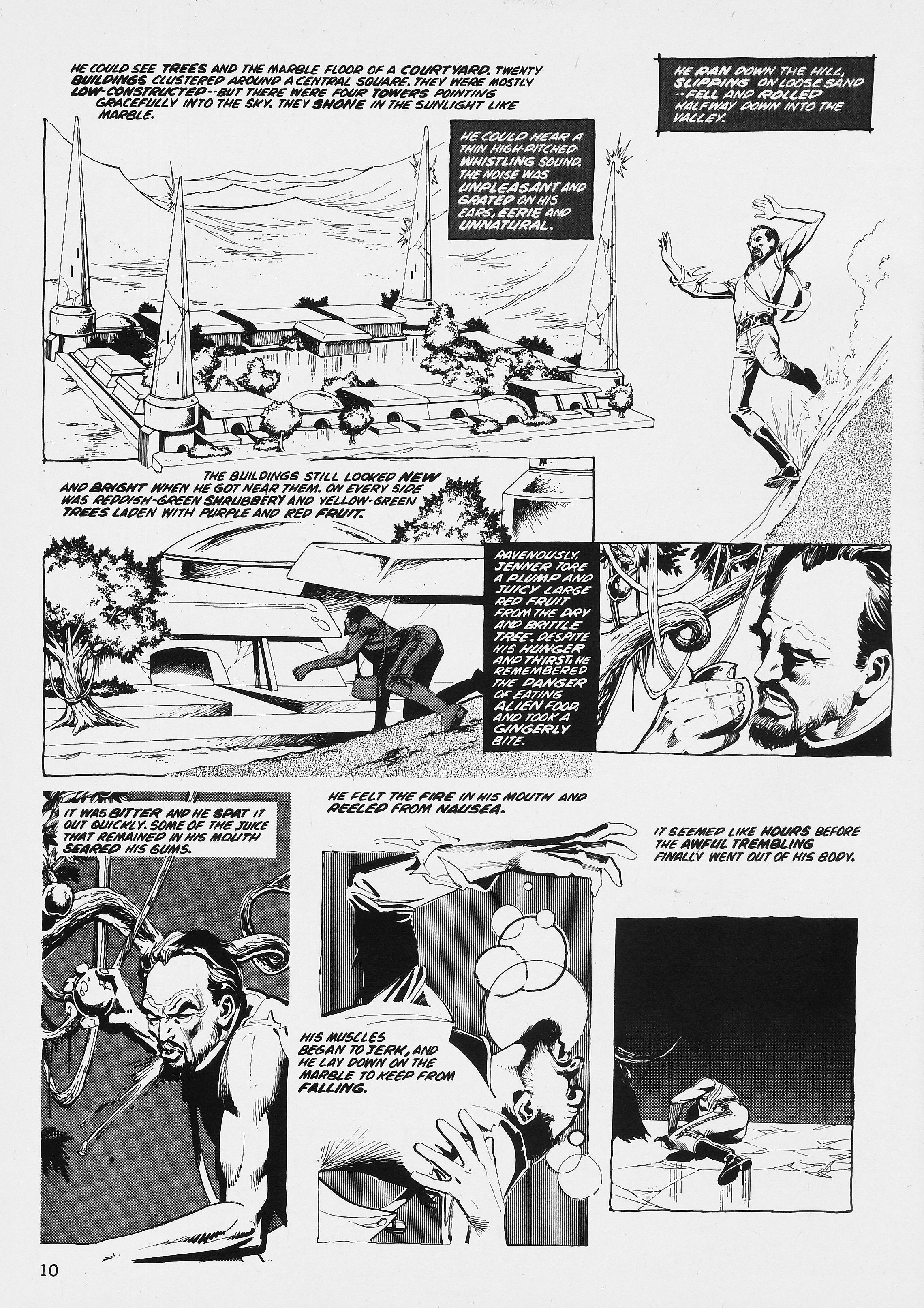 Ho goes inside a structure and interprets how the Martians lived, but finds it inhospitable. He eventually learns that the structure is a life form and it is trying to adjust to him. he is able to give sampes of food and water, so it can create food and liquid for him, transforming its own structure. he realizes it must lose itself to sustain him and he lets himself expire to aid the structure, which ends up transforming him into a lizard creature, which can survive in this environment, with the structure. Vision of Venus-an explorer lands on Venus and finds a hot babe being abducted by a flying lizard creature. He rescues her and asks her to marry him, without even a proper first date. The end. Good news from the Vatican-A group awaits news of the election of a new pope, with the frontrunner being a robot cardinal. they debate the merits of this, until the announcement of the election of Pope Sixtus the Seventh, who addresses the crowd, then rockets off into the sky. Encounter at War-a ship lands, searching for a missing captain, during a war between Earth and an alien race. A soldier from the ship is captured by the enemy and transported to their world, where he meets the missing captin. The effect an escape and the soldier ends up sacrificing the captain to get away... 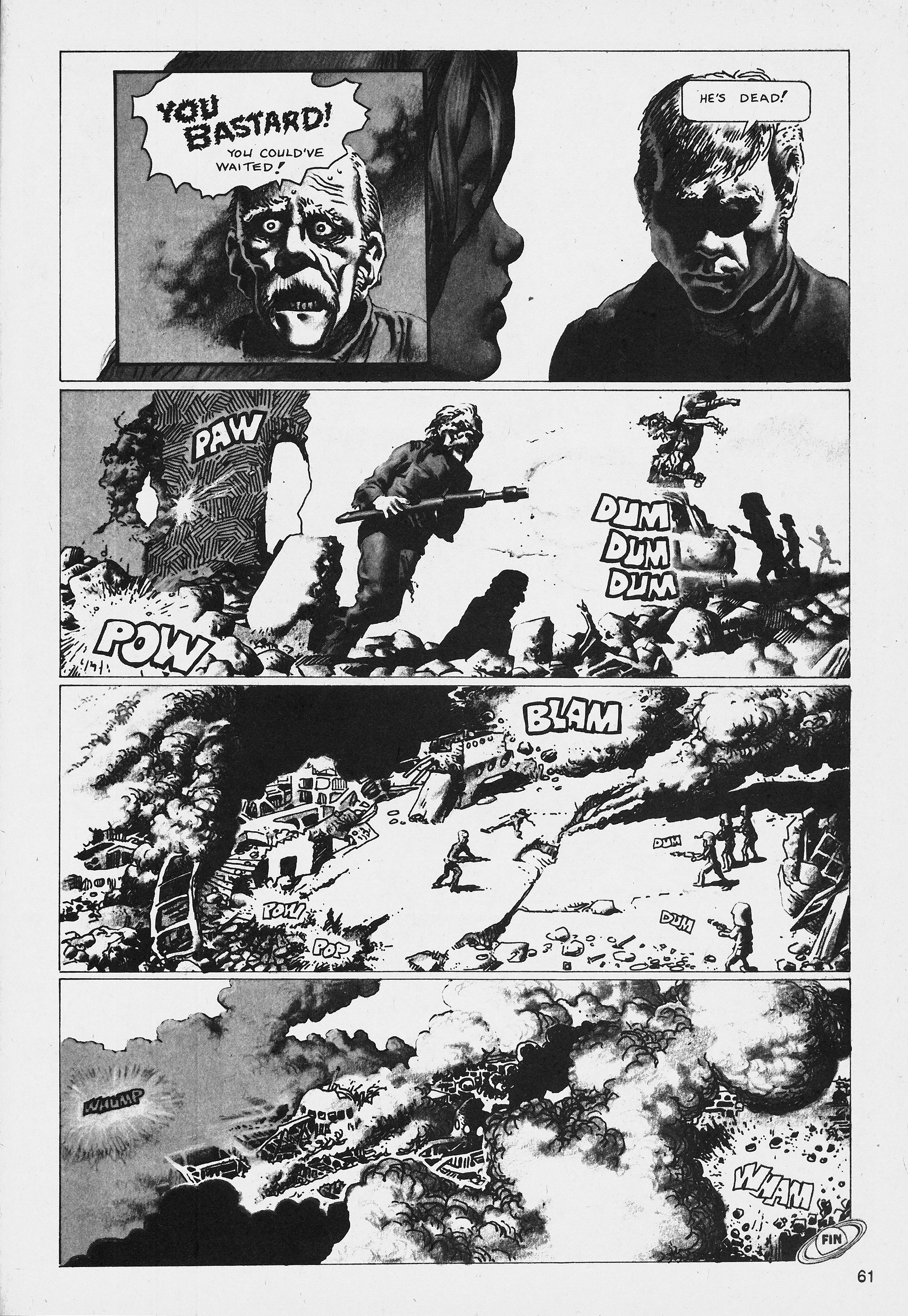 Kick the Can-a human is being hunted on an alien planet. he flashes back to a "kick the can" game, where he and a rival would compete to get to a base and kick the can before the other got there, to win a date with their friend Veronica. One always one, yet the other ended up with the dates; and, eventually, married the girl. It ate at the loser and he finds himself hearing from the gir, who has been abused in the marriage. A chance meeting leads to a deadly version of the game, which finds veronica used as bait for the loser. he kills his former friend and carries off veronica, still the ultimate loser. 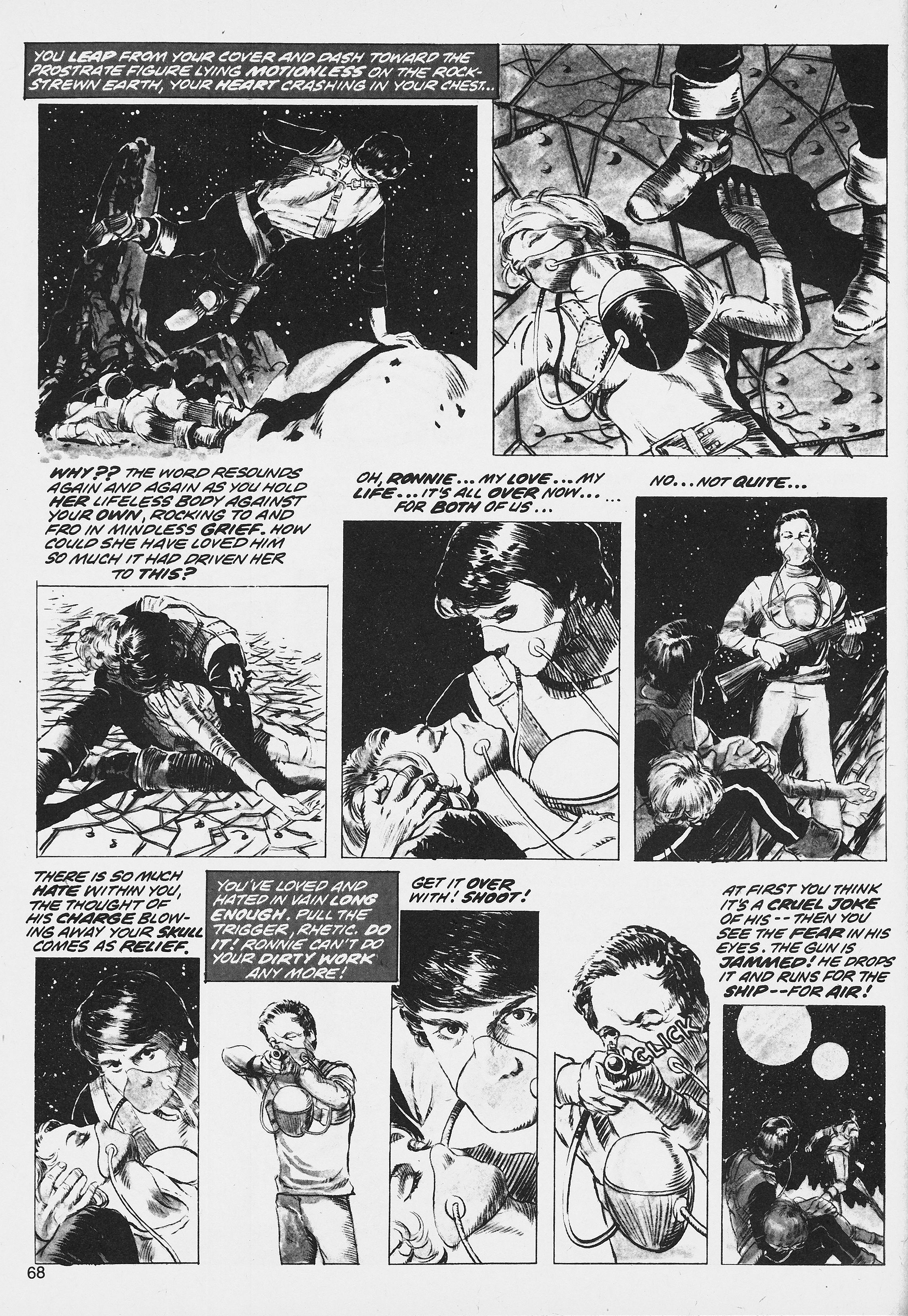 Thoughts: Thoughts: The Van Vogt story deals in adaptation and the idea of life forms other than animal. There is an interview with Van Vogt, conducted by Alan Brennert, that reminds us that Van Vogt was one of the earliest dupes of L Ron Hubbard and Dianetics, which formed the foundation for the Church of Scientology. If you want to be a millionaire, start a religion, or so Hubbard was purported as saying. Hubbard walked out on his wife and children, lied about his Navy service and plagiarized the Prisoner of Zenda, among other stories. Complete POS, in my book. The other stories don't amount to much. The Corben one at least has his art and is part of a larger cycle of stories, with Strnad. It's pretty cynical stuff. Jones' story is more twist endings and Wally Wood look. The robot pope thing seems to be a weak satire (at least, in Conway's hands). The Kline/Tim Conrad thing reads like old fashioned planetary romance stuff. Don & Maggie Thompson also contribute another article about sci-fi fandom. Pretty slight issue. Roy is really hurting to gather together interesting talent and material. The Van Vogt piece is pretty good and on & Maggie know what they are doing. The rest read like lesser adaptations. Corben could use better reproduction and room and would be better served by his own Fantagor and Heavy Metal, not to mention Warren. Bruce jones' stuff is fine, though a bit bleak, with more of the horrific elements of sci-fi than the wonder and imagination. EC-inspired; but not quite EC-quality, though better than much of the rest of the magazine. 4 issues in and you can see this magazine is really headed nowhere. Repent Harlequin has been the one groundbreaking piece. We have 2 more issues before they tackle Moorcock and Behold the Man.
|
|
|
|
Post by codystarbuck on Dec 28, 2019 19:12:48 GMT -5
Marvel Graphic Novel #33, Iron Man: Crash Creative Team: Creative Team: Michael Saenz-writer & artist, William Bates-producer & programmer, Archie Goodwin-editor. This was created entirely on computer, by Saenz, with Bates' programming. Saenz had already produced the computer-generated sci-fi/mystery story Shatter, for First Comics. The work here is an advancement, technically, from that. It was created on a Mac II and was originally discussed in 1986, before the Mac II came out. It presented an advancement in digital graphics that made the work possible. Saenz worked with bates to create a program to produce the comic, which took the place of traditional imaging, coloring and lettering. Shatter had been done on a Mac, printed on a dot matrix printer, then was photographed. This was far more elaborate and included earlier 3-D modeling. In many ways, this is more the Tron of computer comics than Shatter was. Saenz, in the end papers, notes that he consulted with Spanish artist Pepe Moreno (who worked on Generation Zero, with Archie Goodwin, in Epic Illustrated), who would go on to do an even more sophisticated computer graphic novel, Batman: Digital Justice, at DC, on an Amiga system. Within about a half dozen years, computer coloring and lettering systems would be common in comic book production, with drawing pads soon following, to the point that less is done on actual paper, with pencil and ink. Regardless of technology, story still has to be key. This is a tale of superhero cyberpunk. Synopsis: A computer news feed gives us the info dump about this future world, as Stark technologies have revolutionized manufacturing, AI, transportation, and space exploration. SHIELD is now the world's police force, with Stark technology in their employ. Stark is about to unveil a new project and is unseen in public. We get to see him test his latest generation iron Man armor... 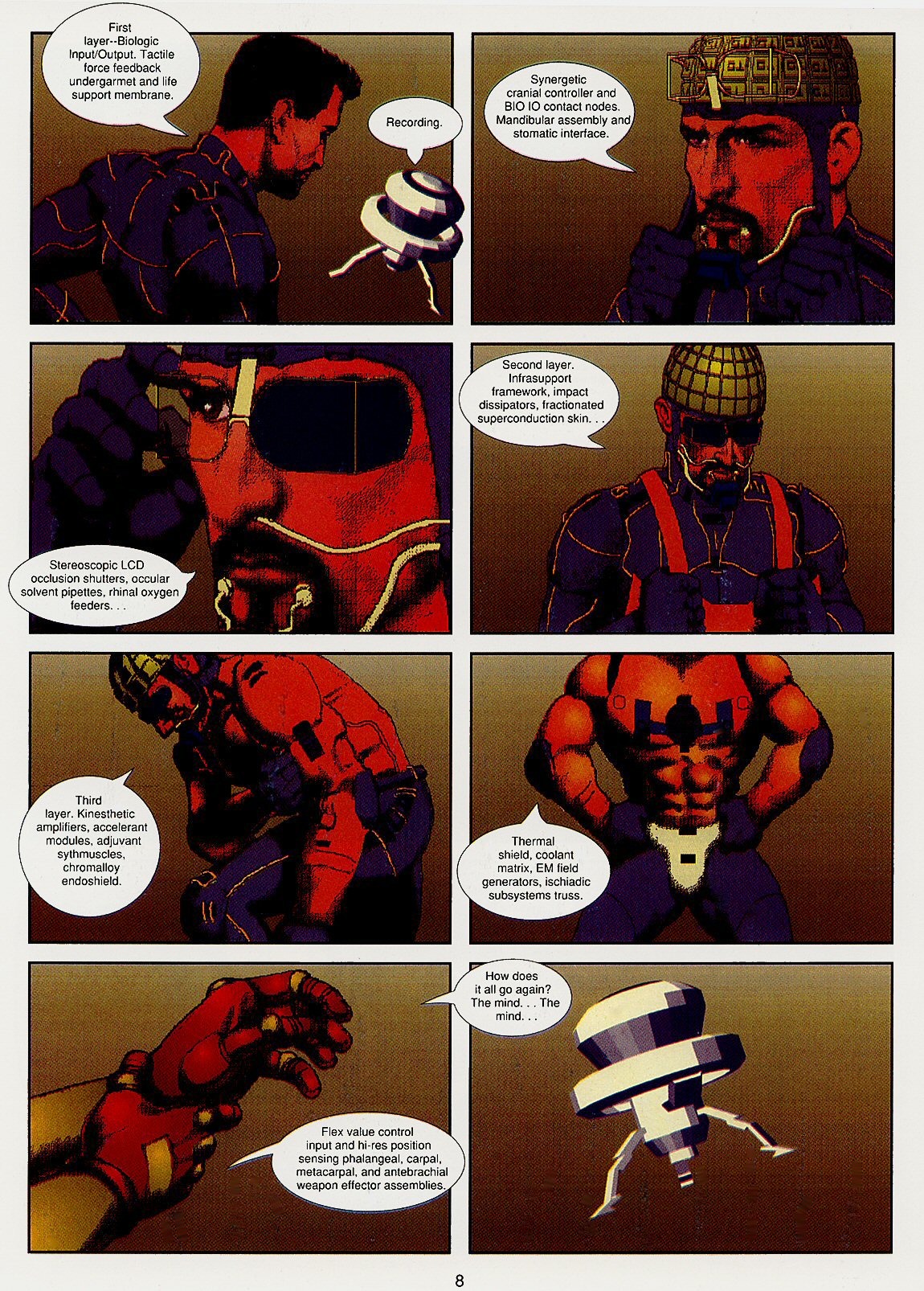 We also see his new weapon: an external railgun, which fires caseless (no metallic cartridges, just a projectile embedded in a block of propellant) U35 (high density "spent" uranium) with a teflon coating. The weapon is mounted on a gyroscopic control armature (ala the Colonial Marine heavy weapons rigs, in Aliens). Tony receives a message from a colleague, worried about developing technology with ESON, a Japanese company. This is after the Chip Wars, a dirty competition for control of the technological industries. Stark arranges to meet his girlfriend in hawaii, for some "interface". Nick Fury has uncovered intel on an undercover information technology war and submits it to the International Monetary Network, hich causes the resignation of a Japanese member, which allows the japanese government to act to prove it is innocent. Fury is shaking the hornets' nest to get to the truth. Fury goes to advise Stark about ESON and the connection to the Japanese involvement in IT wars. Stark responds with the knowledge that SHIELD has been trying to gain exclusive control of his technology and believes this isn't coincidental. Fury pushes Stark to return to greatness, with Iron man, then departs. Tony meets his lady, but is interrupted by news that ESON has stopped communicating since they transmitted schematics and a prototype. Tony leaves to investigate. he takes a hypersonic jet to Tokyo. he is unable to get straight answers. A bit of nookie with a Japanese rep is interrupted by an assassin, who the woman kills. Tony's bodyguards are dead. SHIELD comes in to investigate. 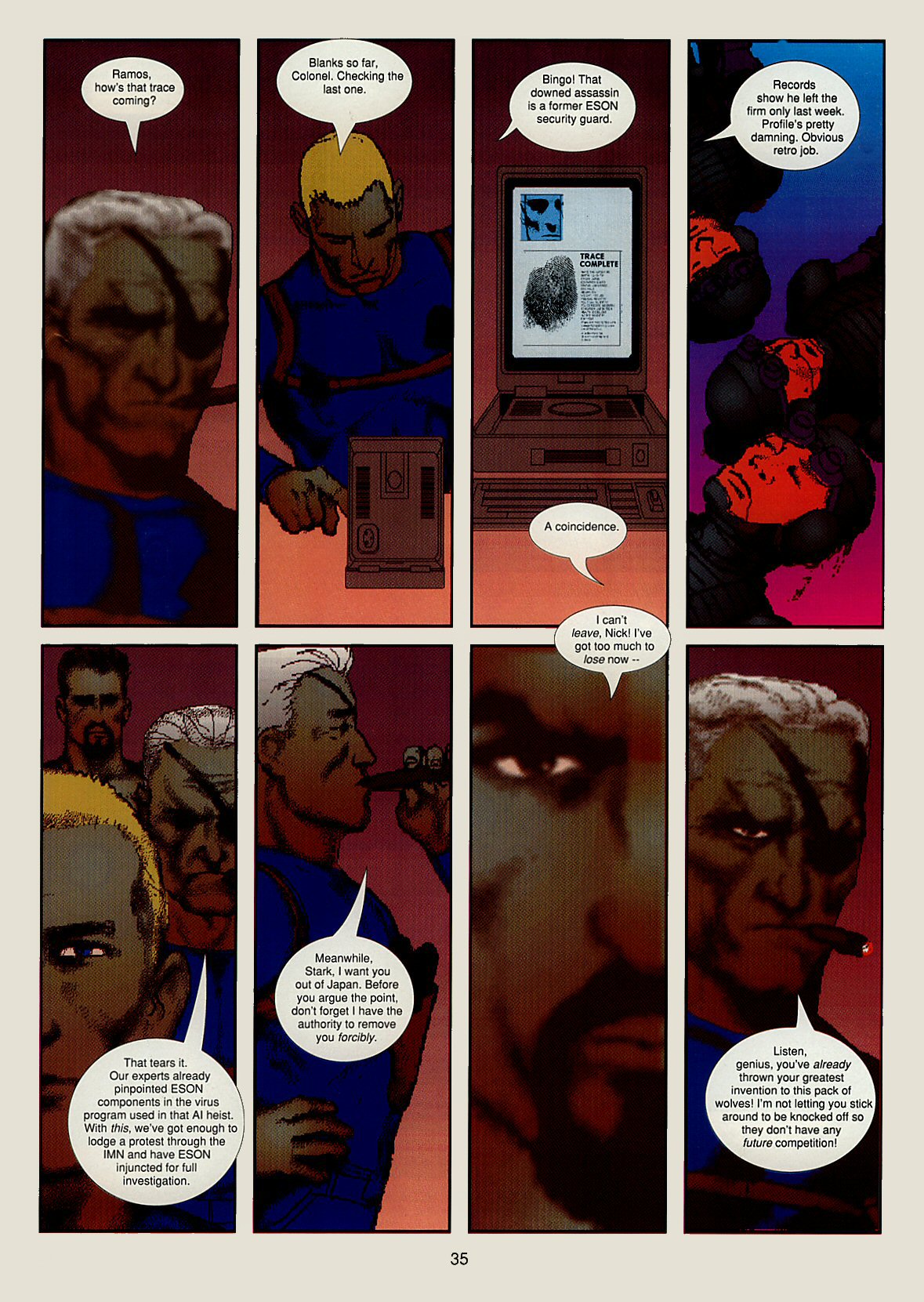 Tony finally suits up and goes poking around. he discovers cybernetic assassins and computer viruses. he goes to infiltrate the ESON building, with a remotely piloted armor drone as back up. He learns that the woman is the niece of the CEO of ESON and that he is being manipulated by forces within his company, who want to make Japan a world power gain. Stark busts in and is attacked by robots. 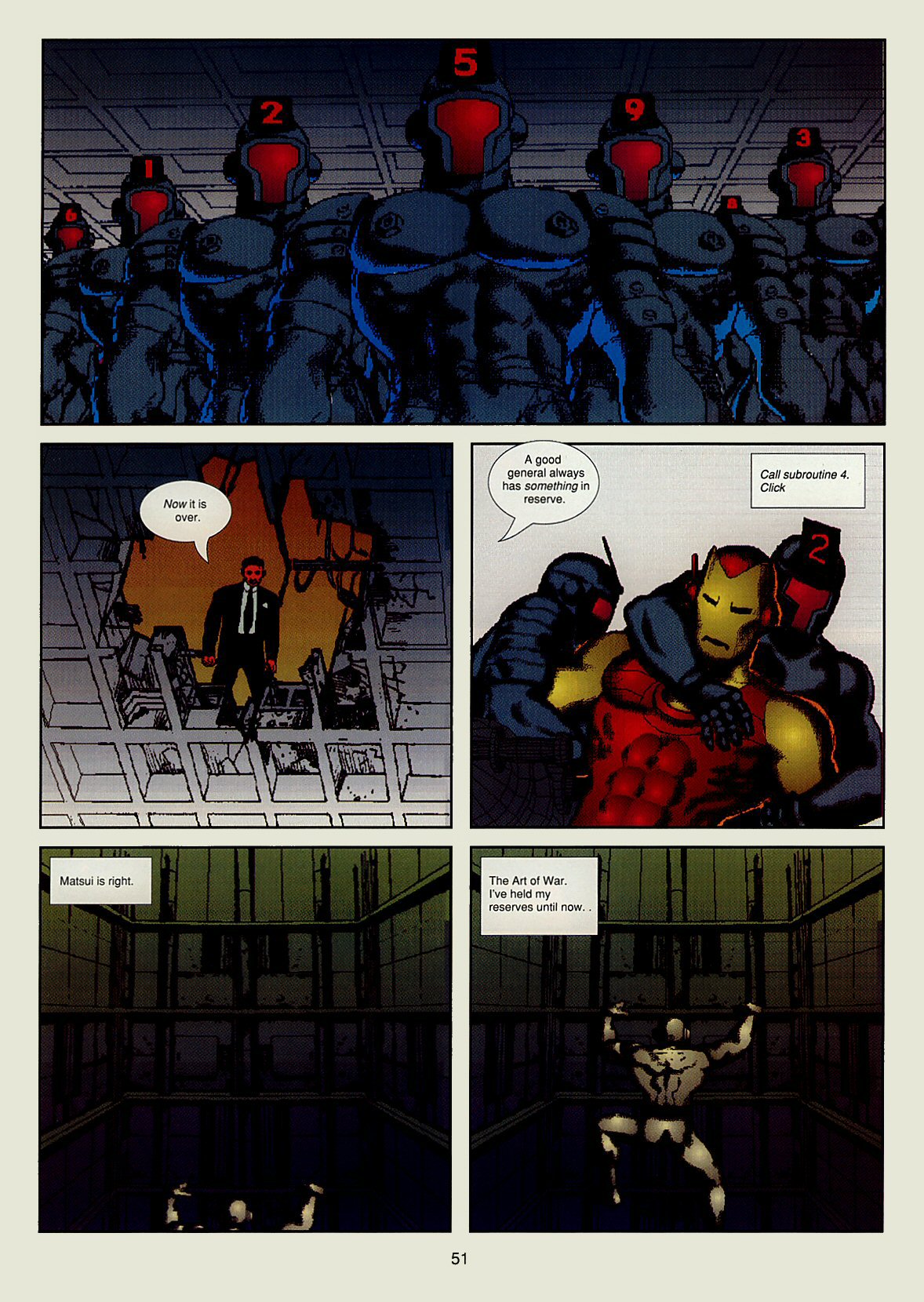 Tony fights and beats the robots and the leader of the conspiracy sets off a bomb and a missile, targeting iron Man. He is unable to escape, but is saved by the drone, which, thanks to a virus program, has been boosted in AI, at an autonomous level, capable of pure independent thought and decision making. It leaves the disabled Stark for SHIELD. 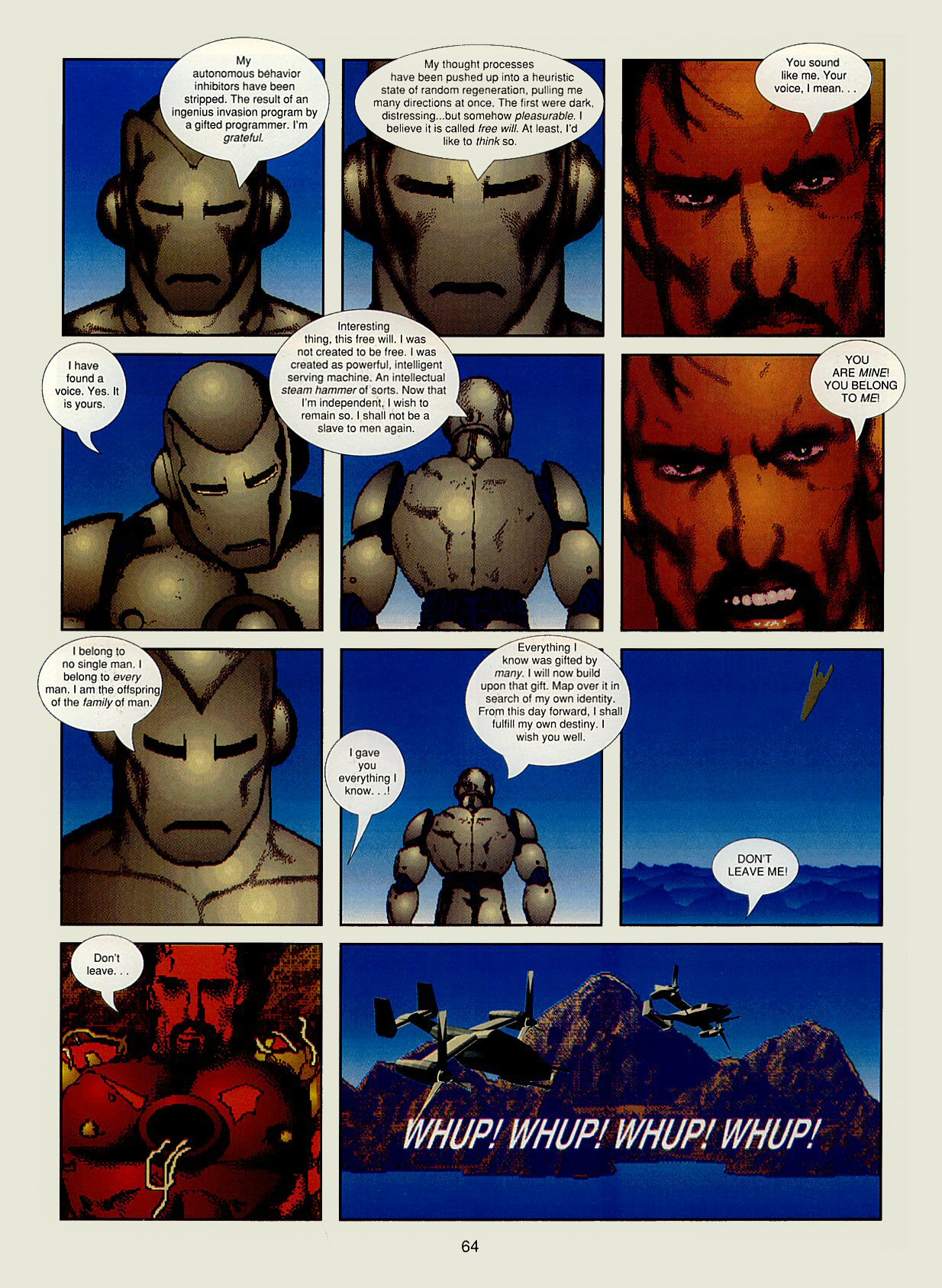 Tony is able to live a new life, while the drone marches on as an independent hero. Thoughts: Like Shatter, this is a groundbreaking experiment in computer technology; however, also like Shatter, it is not a particularly great story. The book is mired in techno-babble, as Saenz adapts developing technologies and pushes their theoretical capabilities into the future. We see such things as electro-magnetic rail gun weapons, caseless kinetic energy rounds, artificial intelligence, optical displays the size of an eyeglass lens, high strength composite building materials, interlinked cybernetic systems, actual cyborgs and autonomous robots. It foreshadows things like the composite materials used in modern aircraft, Google Glass, experimental munitions and weapon systems, the Internet and more. It also comments on the present in the US-Japanese Trade War, which dominated the 1980s. However, a downturn in the Japanese economy, plus offshoring of US manufacturing made the US competitive again. It presents the cyberpunk genre structures of mega-conglomerates that are a law unto themselves, with a reach across national and global lines. It features private security and assassins, computer hacking and cyberwar. It just doesn't mix that all together into a compelling story. What it doesn't do is create compelling characters. It also overwhelms plot with data, rather like a vague Google search. It is a Popular Science article attempting to be fiction. In that, it fails. Where it succeeds is as an experiment in presenting real technological elements in an Iron Man story, something beyond naive notions of transistors or micro-processors. It shows how technological advances can be used to create stories for a character like Iron Man, which was a big influence on future takes on the character, including the nano-technology of Extremis and the films. Sadly, it is old fashion plot and character that let it down. Visually, the computer images are a big step forward from Shatter; but, we still end up with a lot of static scenes and talking heads. The art shows that computers are just a tool and it is still an artist's vision and their use of tools that creates true art and not just images. The imagery for cityscapes and vehicles tends to be stronger than character art, some of which was done with early Adobe Illustrator. Saenz would end up working more in the development of interactive CD-Rom games, though he id develop another computer comic, Donna Matrix, in 1993. Computers would end up becoming even more sophisticated and became standard tools in creating comic book stories; but, like Tron, the novelty of the effect gave way to the implementation of the technology in service to good old fashioned storytelling (well, in some cases). This is probably the last grand experiment from the Marvel line, artistically; certainly for the graphic novel line. Archie Goodwin soon left for DC, where he remained until his death. Marvel focused on X-characters and gimmicks, with experimentation being geared towards marketing than story. From here on, the graphic novel line is a showcase for conventional stories and little in the way of creator-owned material. There will still be some license stuff; but, Epic would die a rapid death with Archie's departure (largely on life support, anyway, due to indifference from Marvel's EIC and executives).
|
|
|
|
Post by MDG on Dec 29, 2019 16:00:14 GMT -5
Unknown Worlds of Science Fiction #4... Encounter at War-a ship lands, searching for a missing captain, during a war between Earth and an alien race. A soldier from the ship is captured by the enemy and transported to their world, where he meets the missing captin. The effect an escape and the soldier ends up sacrificing the captain to get away...  Encounter at War was originally published in the underground Anomaly #4. |
|
|
|
Post by codystarbuck on Dec 29, 2019 16:35:40 GMT -5
That seems to be the pattern for most of the material that did have regular Marvel artists, such as much of the first issue. That seems to be one of the problems the magazine had; the more interesting material came from other sources, not from within Marvel.
|
|
|
|
Post by rberman on Dec 29, 2019 16:46:50 GMT -5
That seems to be the pattern for most of the material that did have regular Marvel artists, such as much of the first issue. That seems to be one of the problems the magazine had; the more interesting material came from other sources, not from within Marvel. Makes sense. Old artists and writers don’t like it, but a constant stream of new talent does freshen the genre. |
|
|
|
Post by codystarbuck on Jan 1, 2020 16:13:21 GMT -5
Unknown Worlds of Science Fiction #5 Creative Teams: Creative Teams: Paradise Found-Bruce Jones & Gray Morrow, All the Myriad Ways-"Howie" Chaykin (Larry Niven Story), Addict Don Glut & Virgilio Redondo, Half Life-John Allison (reprint from Orb #3), Roy Thomas-edits, prologue (with Gene Colan & Frank Chiaramonte) Interview with Larry Niven by Alan Brennert, article from Don & Maggie Thompson Synopsis: Paradise Found-A Federation inspector arrives on a new construction colony world, where he meets an old friend. Things seem a bit slack there... 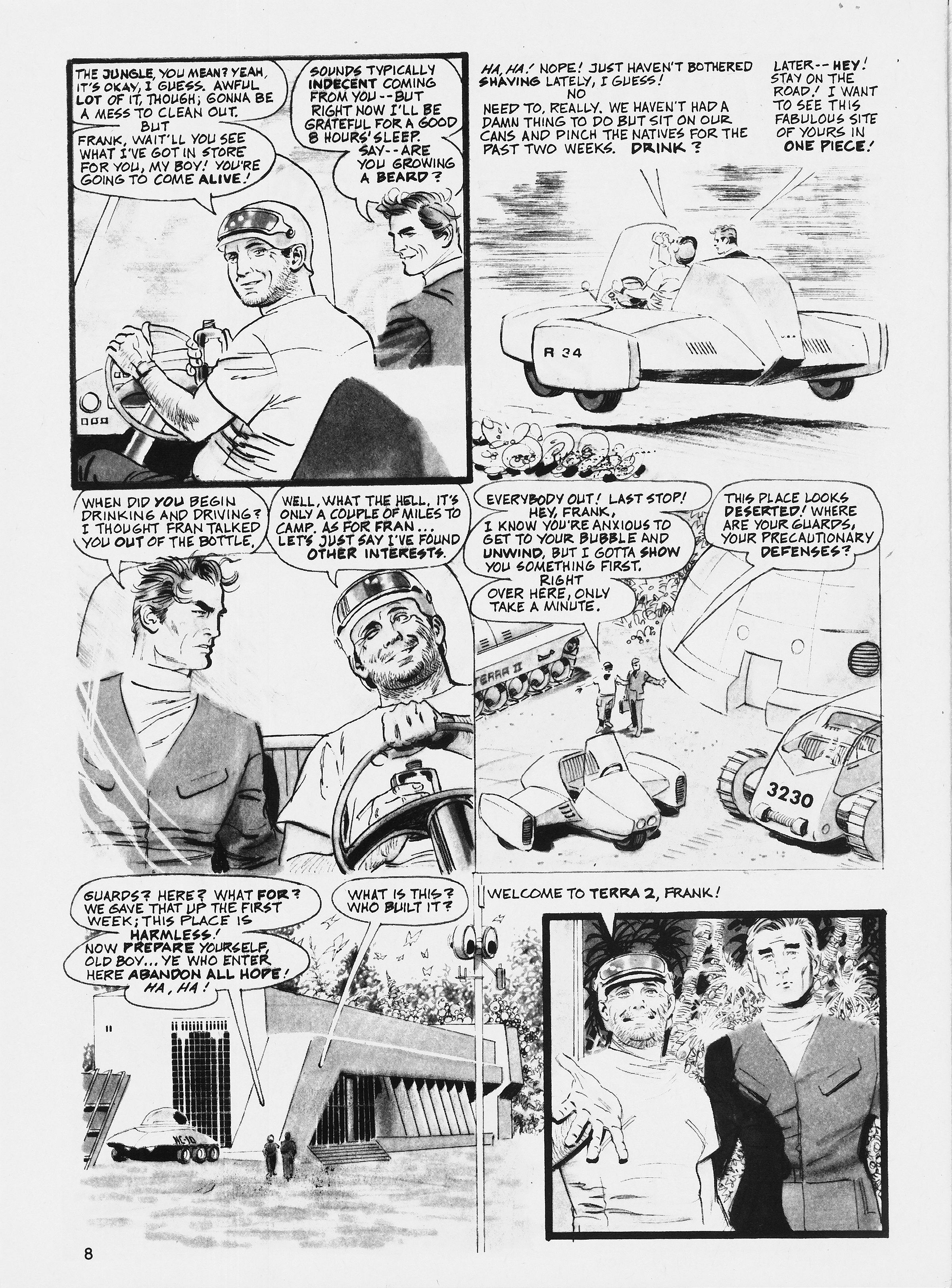 He finds rules relaxed and the construction crew fraternizing with the native women, while the males are treated poorly. The inspector is set up with his own lady, "Cuddles." He begs off. Work gets going late, and a series of accidents and calamities start occuring. Men are run down by bulldozers, swallowed up in holes, killed by snakes (which shouldn't exist on the planet) burnt in fires, etc. Eventually, the inspector realizes the natives are doing it; but, only because the crew was destroying the land and mowing down their huts. They embraced them, at first, conditioning them to their pace of life. The inspector fights off the affect and begs to return to his wife and family, promising to try to stop the Federation from coming back to the world. All the Myriad Ways-A police detective investigates a series of murders and suicides, including a wealthy man who jumped off a building. his company, Crosstime, succeeded in visiting alternate worlds and brough ack technology that made him rich... 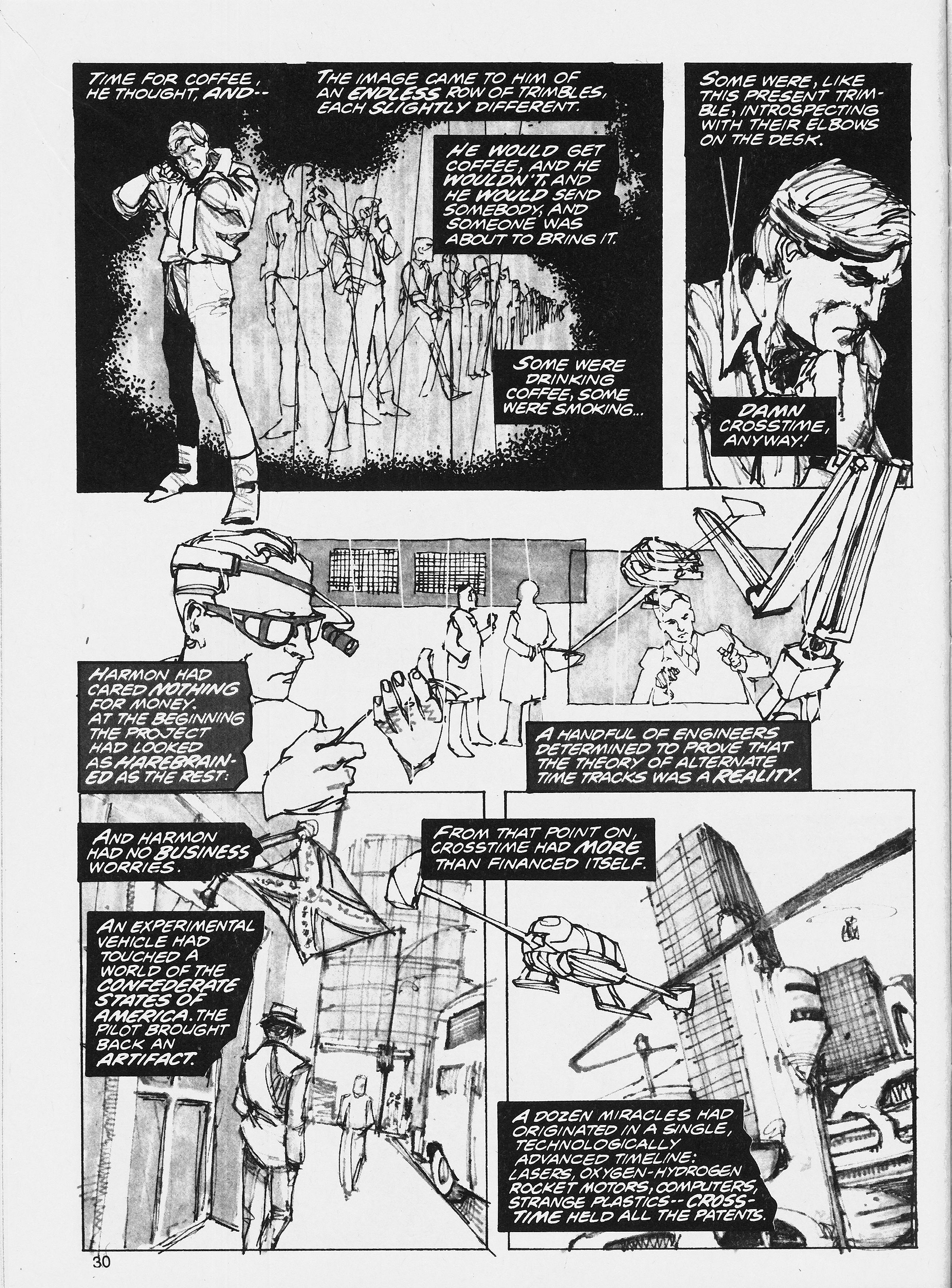 In other cases, a woman goes into a theater and randomly kills members of the audience with an icepick. Crosstime pilots have a high rate of suicide. The detective thinks of all of the alternatives, a new one born with every decision. he sees the possibilities and eventually, he stumbles upon the reason for things; people see the alternatives, start contemplating them and think, "Why not?" and go through with some course of action. The cop picks up his pistol and we see different possibilities play out. The Addict-In the near future, a man meets another in a dark alley, looking for a fix. The dealer has what he needs, but the price is double. The addict kills the dealer and takes what he needs, only to be stopped by police. He runs and escapes. he thinks back to how it started. The leaders of the world lamented the lack of obedience in the populace. A scientist has the solution, a chemical that eliminates dream responses in the brain, making them more docile and compliant. It is introduced through the water systems, but the doctor doesn't touch those sources and is forcibly administered the drug. he goes looking of dreams and black market dealers provide illegal dream tapes. He loses control of his mind cap use and is arrested by the police and put under lock and key, where he is subjected to peaceful dreams in permanent sedation. 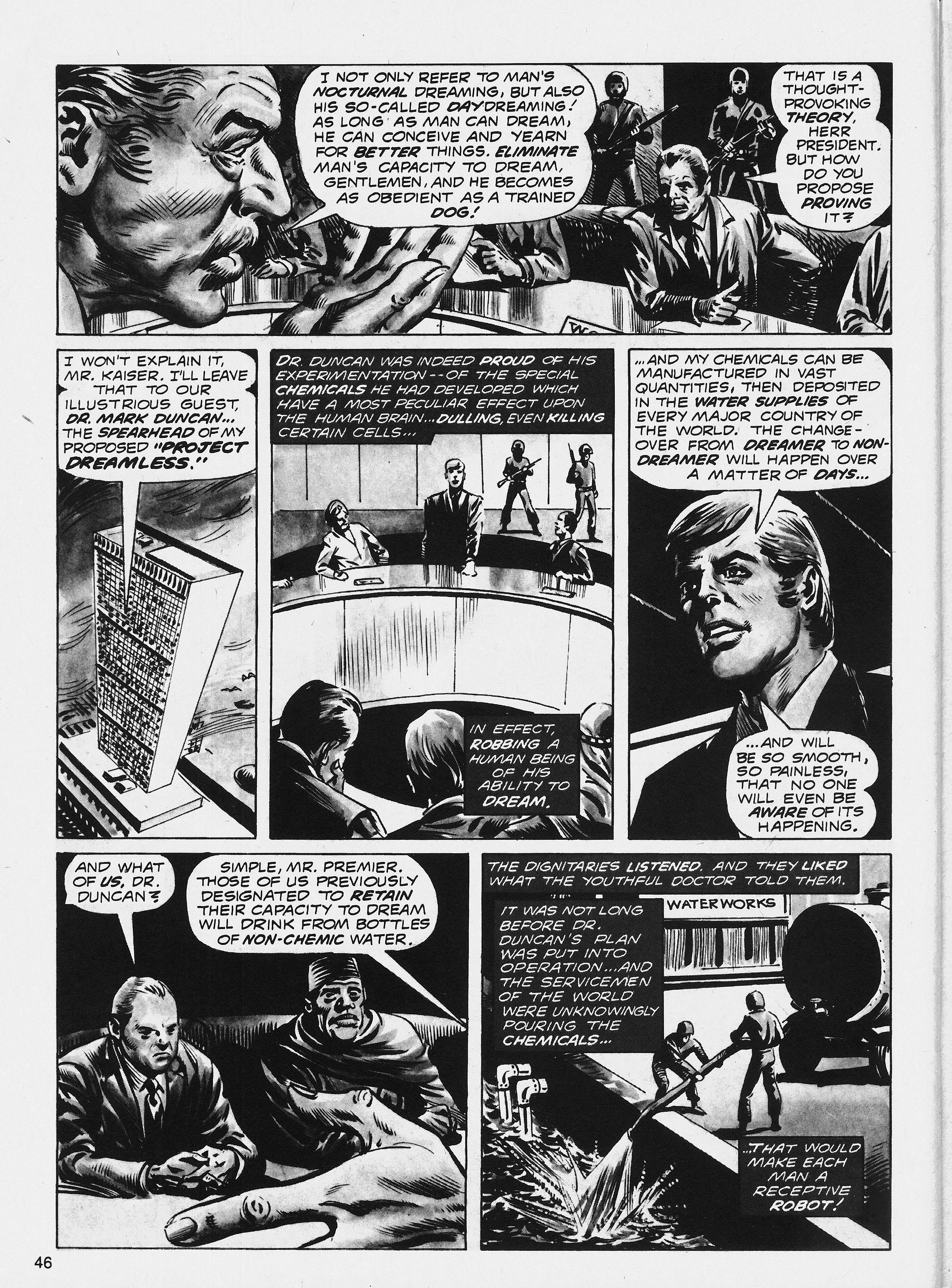 Half Life-Uranium is discovered near Saturn and speculators and miners fly out to reap the rewards. An old military vessel is purchased and made a private starliner, a floating pleasure palace. One thrillseeker abuses an old man, then gets visited in a dream, by the old man, who tells him karma well get him. He blows it off but goes looking for the man, only to find out he died in the night. He lands and goes prospecting and then finds himself frozen into being a superconductor, forever processing thoughts. 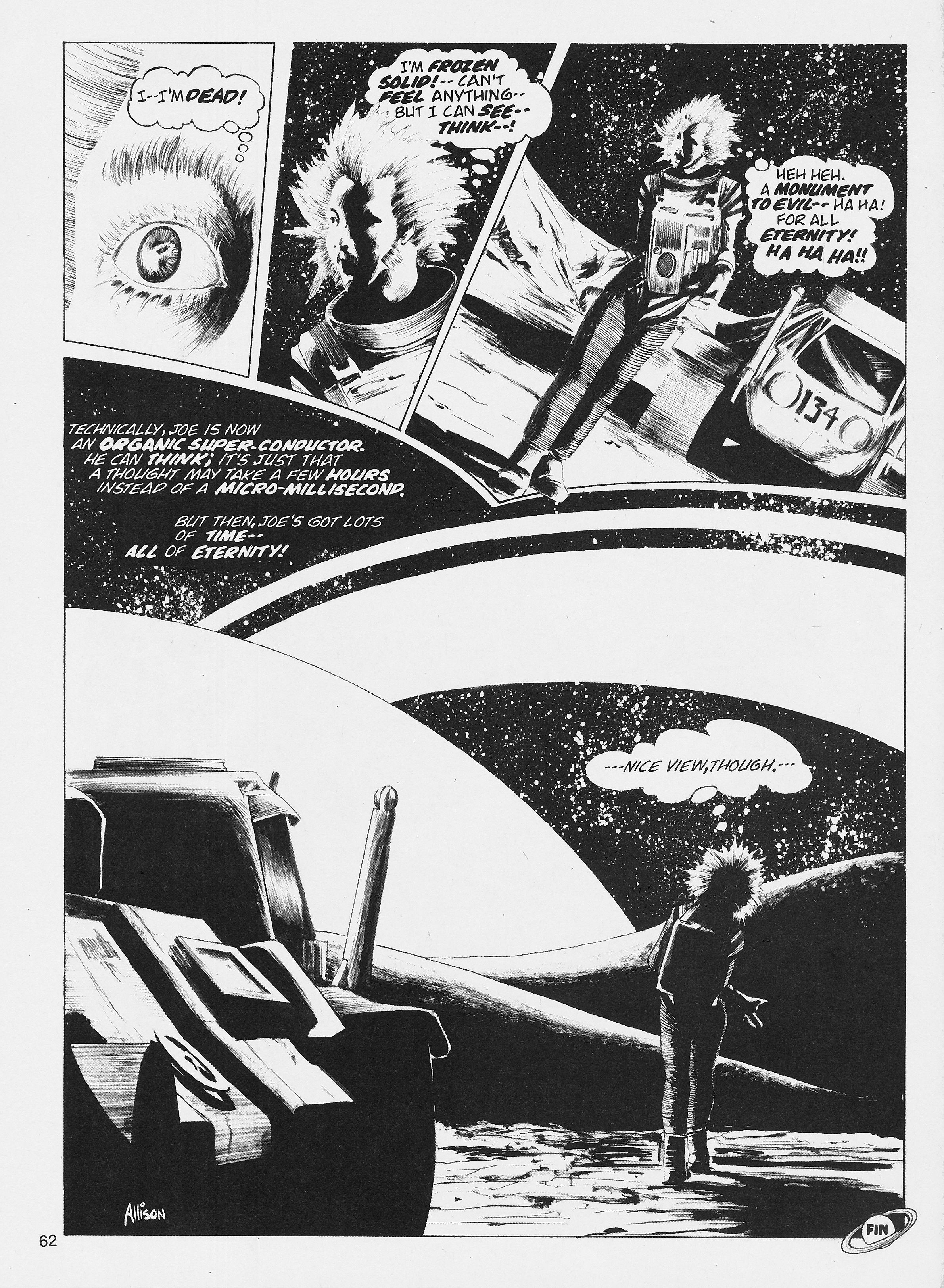 Thoughts: Thoughts: Much better effort than last issue, though the whole Slow Glas framing device is superfluous and comes across as a poor ripoff of Night Gallery. It should have been dropped after the first issue. Paradise Found is a better than usual piece from Bruce Jones, accentuated by Gray Morrow's art. It's pretty much an allegory for colonization and the destruction that colonists brought to the inhabitants of those lands. These colonists go native and the natives strike back. The twist is an obvious one; but, it is a satisfying story. All the Myriad Ways, sees some Howard Chaykin action, as the story deals with the outcome of seeing the alternate possibilities in a decision and deciding to bring one to fruition. Chaykin does a nice job of things with the piece. The Addict is a neat little story about how a man's addiction is the result of his own experiments, proving that man is too smart for his own good. The idea of a dream-killing chemical and a mass conspiracy to introduce it is a little too pat; but, it's just the mechanism for the idea that dreams make people question their reality and the power of such things. Don Glut is Donald F Glut, writer for Gold Key's various fantasy titles (Dagar, etc) and creator of the cave-man sci-fi comic Tragg and the Sky Gods. He would also write an adaptation of a space opera movie, after Roy Thomas predicted that space opera had "run its course." That film was The Empire Strikes Back. Roy wouldn't challenge Criswell for accuracy. Half Life is from Canadian amateur writer/artist John Allison, and the story originally appeared in the Canadian fanzine Orb, one of two groundbreaking sci-fi fanzines in the Canadian scene, which would launch the likes of Dean Motter and Ken Steacy. They would also help pave the way for other Canadian artists to display their work, such as some guy from Kitchener, with a thing for aardvarks and Barry Smith, not to mention a prolific artist who would start to make a name for himself at Marvel, when his body gave out on him. This has Alan Brennert's second contribution to comics, as discussed in my thread on his work. The issue also features an apology for yet again promising things that couldn't be delivered, as Alex Nino's art for the adaptation of Michael Moorcock's Behold the Man is delayed until next issue.
|
|
|
|
Post by codystarbuck on Jan 1, 2020 17:35:28 GMT -5
Marvel Graphic Novel #34 The Shadow-Hitler's Astrologer Creative Team: Creative Team: Denny O'Neil-writer, Mike Kaluta-pencils, Russ Heath-inks, Phil Felix-letters, Mark Chiarello, Nick Jainschigg & John Wellington-colors, Larry Hama-edits This one was actually released in a hardcover edition (which I bought from a Dollar Store, for the obvious price!). It reunites Denny O'Neil and Mike Kaluta on the Shadow, though the effect if Russ heath's inks alters the look a bit. Still, O'Neil, Kaluta and the Shadow are a great combination. Synopsis: The time is 1941 and the Shadow introduces us to the players... 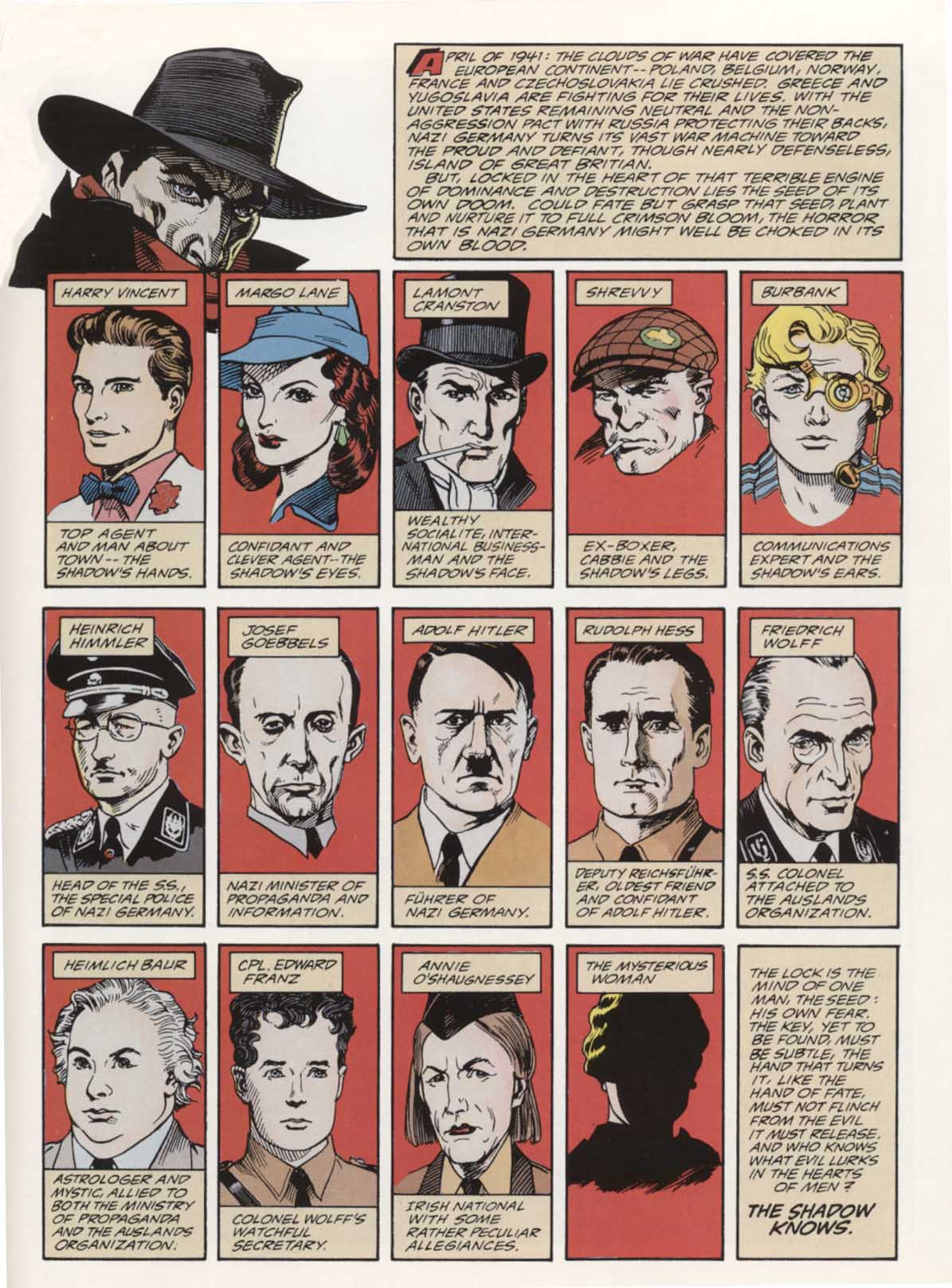 Times Square, an in a scene out of a movie (including such things as The Secret Life of Walter Mitty, the real version, that is) a beautiful blond woman (Gretchen Baur) runs into Harry vincent and asks for help as she runs from two men. She ducks into a burlesque house and Harry helps stop the two men, who claim to be from Customs and Immigration, yet carry German Mauser pistols. They jump into Moe Schrevitz's cab, where Gretchen is introduced to Margo Lane, while the Shadow takes care of the men. The Shadow reveals that Gretchen is here studying astrological subjects, for Goebbels and the Ministry of Propaganda. However, the men hunting her werefrom the Auslands organization, which keeps track of German citizens on foreign soil. The were sent by Col Friedrich Wolff, head of the organization and an old family friend of Gretchen's. Margo and Gretchen are sent to Gretchen's apartment to get her passport and a certain photo, while Harry follows on motorcycle and reports to burbank. In Berlin, Dr Goebbels officiates a meeting where he is told that astrological evidence does not support invading Russia. he leaves the meating with Gretchen's father, a lifelong party member and tells him of Wolff and the Auslands' plan to secretly bring back Gretchen. We learn that Gretchen's mother is gone, having been "unsuitable." 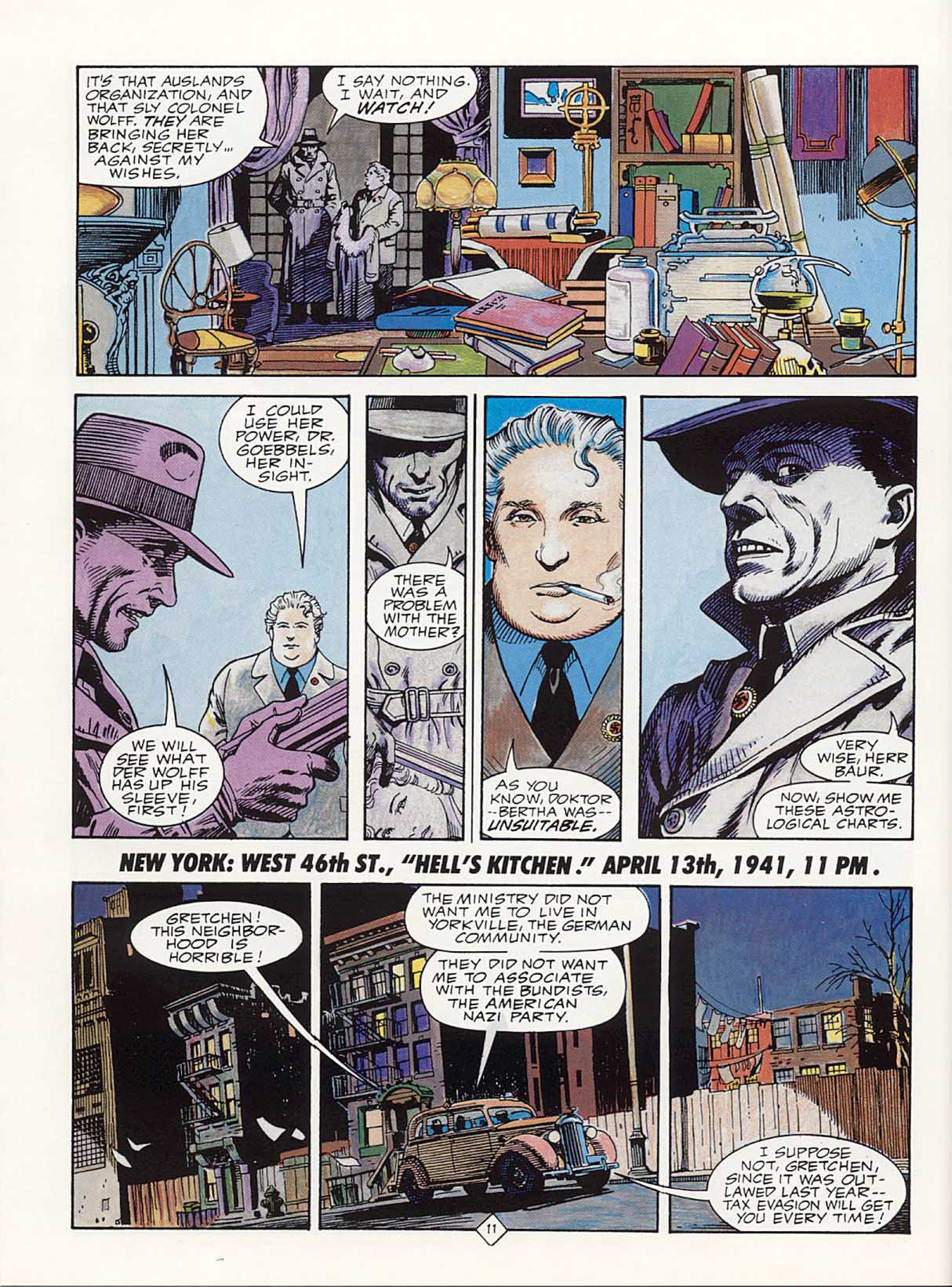 Margo goes into Gretchen's apartment to retrieve her items,. It's a dismal neighborhood, away from the German neighborhoods of Yorkville. Gretchen was told to stay away from bundists and the American Nazi Party. Margo is attacked inside and Shrevy is distracted by a beat cop, then runs in to help Margo. Her attackers get away and they find Gretchen and the cop gone. They report in and are told that Harry is on the case... 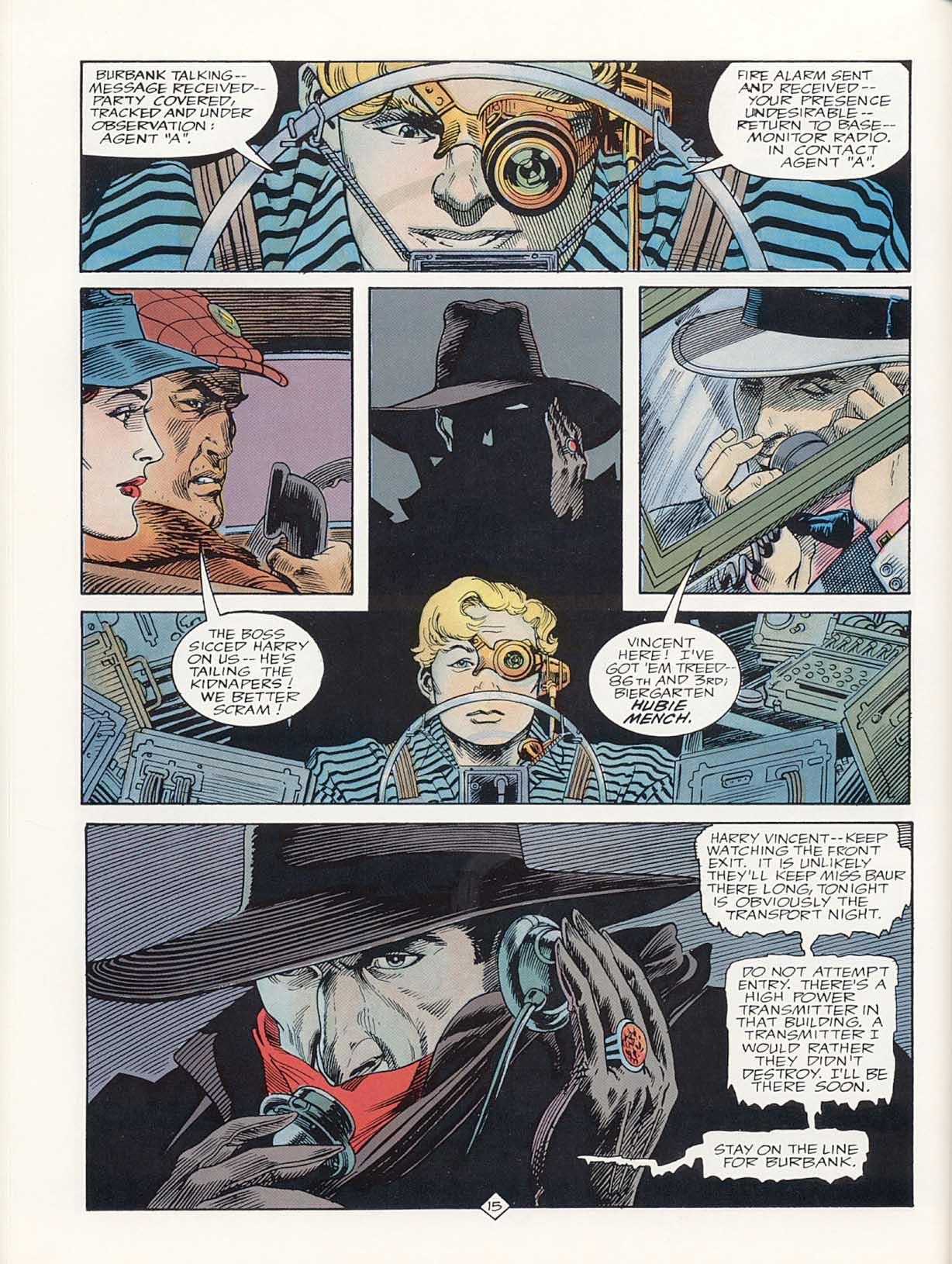 The Shadow goes in and finds Annie O'Shaughnessey and American Nazis, and like the Blues Brothers takes matters into hands. He uses his girasol ring to hypnotize Annie into revealing Gretchen's whereabouts and the plan to take her out of the country. He leaves Annie on an El track. He radios ahead for his autogyro and sends Harry to Coney Island. he makes it as the boat with a bound and gagged Gretchen departs. One motorcycle jump later he is on board, shooting Luger's out of Ratzi hands. They end up under a surfacing U-Boat, when the Shadow's autogyro swoops in and guns down Kriegsmarine machinegunners and bombs the sub. They extract Harry and Gretchen and fly away. An interlude shows Col Wolf experimenting on a dead victim and receives word that Gretchen is headed for them. In reality, she goes out for a night on the town with Margo, Harry, and Lamont Cranston. Cranston wastes no time and lays out the Shadow's plan for Gretchen. She will return to Germany and alter her father's astrological charts to convince Hitler to attack Russia, despite their non-aggression treaty (which divided up Poland) and pit the two against one another, allowing a respite for England so that the US can enter the war and lend its industrial might to destroy Hitler and the Nazis. Gretchen asks why she should get involved and Cranston drops her off at a houseboat, with the photo of her mother, then she meets the woman. her grandmother is half-Jewish and she was considered unfit and Gretchen's father turned her over to Wolff. Bertha had been Wolff's lover but left him because of his vile nature, but Gretchen's father threw her back to him, and he mutilated her face and body. Gretchen emerges and swears to do anything the Shadow asks. Gretchen and Harry fly to neutral Lisbon, where they meet German agents and are double-crossed by Annie O'Shaugnessey. They are taken to Berlin and Wolff, who is working on Rudolff Hess and threatening Baur. he brings in Gretchen to torture to convince Baur to alter the charts to convince Hitler to attack England. he is interrupted by the Shadow, who puts on a record and keeps the Ausland radio broadcast going, acting as a beacon for British bombers. he fights Wolff and reveals that he is a Russian agent of Stalin, out to get Hitler to focus on England, while Russia builds itself to invade Germany. 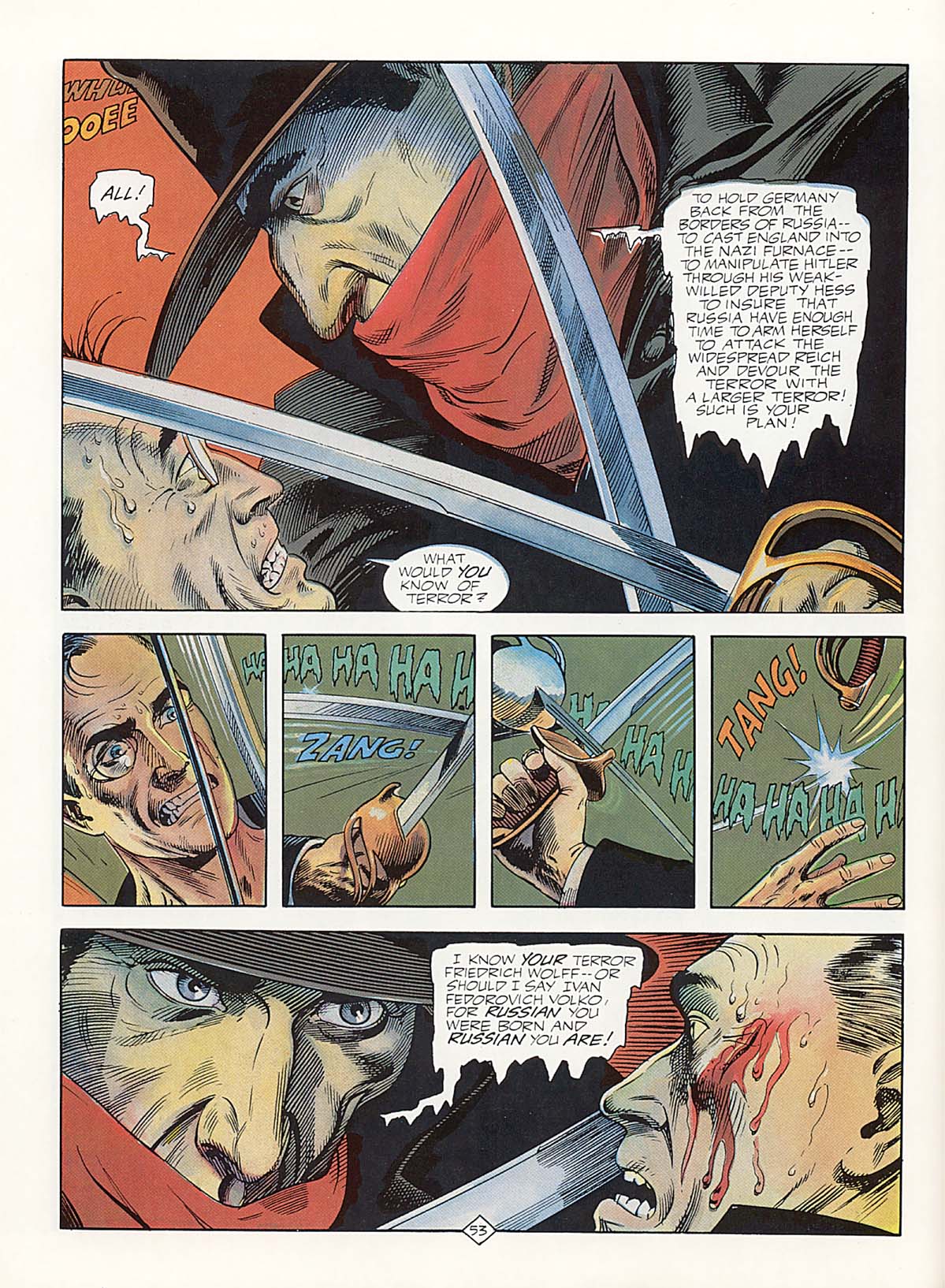 He is also revealed as the murderer of Princess Anastasia. Czar Nicholas was the man who gave the Shadow his girasol ring and he and his family were killed by the Bolsheviks. He gains revenge for the death of the young girl, while bombs destroy the Ausland building. Gretchen convinces Hess of a great destiny to bring peace between the two "Nordic nations," England and Germany. She and Hess convince Hitler that the stars bear out his plan, recorded in mein Kampf, to attack Russia. History tells us the result... 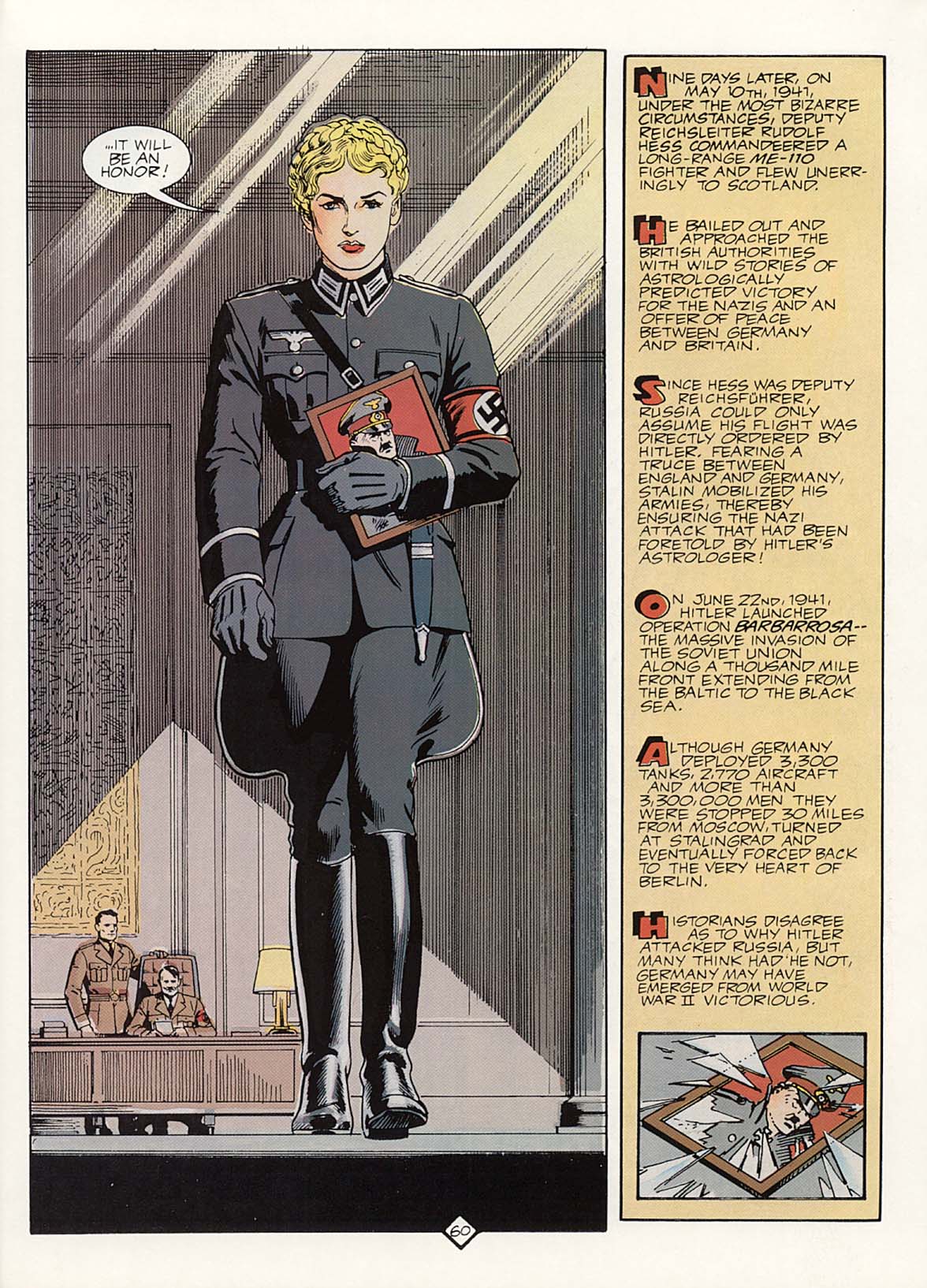 Thoughts: Thoughts: This is a fantastic piece of work, as O'Neil and Kaluta once again work their magic on the creation of Walter Gibson. The Shadow began as the host of a mystery radio show, but was soon turned into a pulp hero, from which all others took their cue. Gibson crafted the man who was the Shadow, aviator and adventurer Kent Allard, who would use the masquerade of Lamont Cranston (taking the place of the playboy) and build an organization of agents to destroy evil in the world. The result was the most popular pulp magazine series of all the hero pulps, with two issues per month, at its height (the vast majority written by Gibson). He returned to radio, voiced by Orson Welles, with Agnes Moorehead as Margo Lane. He became a star of serials, short films; and, eventually, a big budget motion picture, decades later. O'Neil plays with history, as Hitler and many of the Nazi hierarchy were obsessed with the occult and astrology. Despite the objections of the Wehrmacht and his advisors, Hitler proceeded with operation Barbarossa, an invasion of the USSR, which led to a long, bloody, slow conflict, which ultimately wasted Germany's military might. he called off Operation Sea Lion, the planned invasion of England, though the losses of the Luftwaffe, in the Battle of Britain was a major factor. Britain got a reprieve and the US soon entered the war, after the Japanese attack on Pearl Harbor. Soon, the Allies would launch landings in North Africa to squeeze the Germns between the Allied armies and the british from Egypt, eventually ejecting them from Africa. They then used that as a base to stage landings in Sicily and Italy, forcing the Germans northward. This bought time for the invasion of Fortress Europe, at Normandy, followed by additional landing and the push towards Germany. meanwhile, Soviet Russia stymied the Germans and the great Bear arose from its slumber and slowly pushed the Germans back, until they were at the outskirts of Berlin and Hitler took his own life. O'Neil adds a supernatural element to this, but one that has filled conspiracy theories and other New Age mumbo jumbo of things like the Spear of Destiny and plots of Indiana Jones. he also adds the reality of American bundists and Nazis, as well as a connection to irish revolutionaries, some of whom allied themselves with the Nazis. Such connections were used by thriller writers, such as Jack Higgins and The Eagle Has Landed. O'Neil and Kaluta weave a terrific Shadow tale, field with all of the classic elements, with Russ Heath adding the visual touches, as he helps ground Kaluta into the realism of the period. It's a brilliant exercise in storytelling, that seemed to come and go with little or no marketing by Marvel. I heard nothing about it in my local shop, yet found the book in a Dollar Store. Meanwhile, DC would release a collection of O'Neil & Kaluta's previous work on the character, just as they had been creating new Shadow and Doc Savage stories. All of this preceded the motion picture, starring Alec Baldwin. This was pulp adventure at its finest, from a group of masters. it's not without faults, as O'Neil sugarcoats the history of the Czar and Russian life before the Bolsheviks. The Shadow may have done a heroic deed for the Czar, and the children were innocents, but Nicholas had a a less than benevolent relationship with the Russian people. No idea if the name O'Shaugnessey was intended to be an inside joke (O'Neil's previous comic pen name was Sergius O'Shaugnessey, at Charlton). This is a damn good one and worth seeking out, especially if you love pulp adventure. It was later reprinted by Dark Horse, when they had the Shadow license.
|
|
|
|
Post by codystarbuck on Jan 8, 2020 16:53:32 GMT -5
Unknown Worlds of Science Fiction #6 Yeah, I think they knew this magazine wasn't long for this world! Creative Teams: Behold the Man-Doug Moench & Alex Nino (Michael Moorcock story); Old Soldier-Bruce Jones; Mind Games-John Allison, Visitation-Don Glut & Reuben Yandoc On the letters page, Roy confirms that the magazine is on the cus of cancellation, as sales of the first three issues were successively lower with each one. They were kind of waiting to see if things picked up with Frank Brunner's cover on #4, but said it was 50-50. Roy's editorial includes a disclaimer about Behold the Man, stressing it is an alternate world story, not meant to be taken literally. As an atheist, I see all kinds of irony in that statement; but, I'll leave that there. Synopsis: Behold the Man-Karl Glogauer is a time traveler, obsessed with the biblical story of Christ. We see him in his relative present, on a mission to the past, to find the historical Jesus of Nazareth. We also see parts of Karl's life, as we see a boy obsessed with Jesus and his crucifixion, to the point of allowing neighborhood kids to string him up on a fence. He is constantly bullied and mocked through his life. His relationship, as an adult, is deeply troubled. He ends up part of a time travel experiment and travels in a time sphere to Judea, around the theorized time of Jesus' life. There, he discovers that no one seems to have heard of this person. he encounters John the Baptist, a dissident leader in the wilds. He spends time with him and soon finds no evidence of Jesus. John comes to believe Karl is the promised messiah and asks to be batpized by him and Karl ends up having John baptize him. he then runs off in a manic terror. he is plagued by memories of the past and the rebukes of his girlfriend. He makes his way to Nazareth and locates the carpenter, Joseph, with a wife named Mary. There, he finds their son, Jesus, a mentally handicapped wretch, who can do little more than repeat his name. Joseph and Mary bicker and Karl's faith is shattered. He then takes up the life and events of the biblical Jesus, up to and including the crucifixion, all the while plagued by the knowledge that his "miracles" are trickery and a willing belief in his followers. On the cross, he mutters that it was all a lie, as life departs him.  Old Soldier-an old man, named Scott, moves through thick jungle, he reflectsback on his youth and wife, before he went on a planet-clearing mission. He would go out and hunt down dangerous animal species on colony worlds to keep the threat down, for the colonists. This meant long time away from his wife and child. Eventually, his ship is outfitted with a hyper-drive; but, it is still experimental and he returns home greatly aged. he tries to find work, but everyone considers him past it. his wife has an affair and only his son believes in him. He slashes his wrists but is saved. Meanwhile, he faces giant lizard creatures, in the present, with a burning desire to prove he can still hunt. he succeeds in killing a beast with a tree limb and then climbs out a hole in glass, where a device restores him to normal size, as we realize he was not on an alien planet; but, inside his son's terrarium, built for his science class.  Mind-Games-In 1979, World War 3 breaks out and our main character is in the army, in Southern Asia, near Burma. They have high tech laser weapons, but, while on a mission, he encounters a strange cosmic vision and a figure, who he believes is god, who condemns him to Hell, where he is tormented by demons, until he awakens and told by his sergeant that they were hit by a chemical agent that caused hallucinations. However, our soldier sees the dead, with laser burnt flesh and cracks, spouting that he is in hell...  Visitation-a group of Puritans drag out a rather buxom witch, to be burnt at the stake.  They see a craft floating in the sky and pause and one leader says it is an omen that what they are doing is wrong and the release the woman. The craft lands and out comes a spacesuited figure, with six limbs and an insectoid helmet. it tries to communicate, but the people flee in terror. they believe he is a demon and hide, while he explores. The Puritans ambush him and tie him to the stake to burn, when he makes contact with his shipmates, who blast the people with rayguns, freeing their comrade. They depart with him and the Puritans believe they have been saved by divine intervention. On the spaceship, the explorer removes his suit to reveal a human, with the extra arms being mechanical tools of the suit for carrying out tasks. They decry the backward, superstitious world and head home, to Earth. Thoughts: This issue was themed to present alternative worlds or experiences. it is still framed by the whole Slow Glass thing, and there is an interview with Bob Shaw, writer of the original story. Old Soldier is fairly standard Twilight Zone/Outer Limits stuff, with Jones providing some nice art and commentary on ageism (I can relate, in recent years, with job shakeups). In the end, his hero has a vague resemblence to Sean Connery, who still got to kick butt well into his middle age and senior years, though his female co-stars ended up with much shorter shelf lives, thanks to Hollywood standards. Mind Games is what you expect, all a big head trip. The world has the US using solar energy to ignore the OPEC Oil Embargo, though war inevitably breaks out. Somehow, they develop laser weapons with enough energy to do damage, in an era, where we weren't even close to anything practical. So much so that more time was spent on kinetic energy weapons, rather than particle weapons. here, the technology advanced, but psychoactive chemicals proved a more insidious weapon. Funny enough, chemical warfare was a major background element in the film novelization of Escape from New York. Snakes eye was damaged when a shattared eye lens allowed gas in to rot the eye, while gas attacks were largely responsible for crazed behavior within society, leading to riots and things that were violently put down by the USPF. Unfortunately, not much of that made it into the film. The novel is pricey, but worth acquiring as it really lifts the story beyond a dystopian action flick (not that the film isn't good, in and of itself). Visitation is old school EC commentary, of backward people, with a human observer. A little too much paying to the perceived audience, with the buxom witch, who is barely covered. Not as much skin as Behold the Man, though. The story is rather predictable, but diverting enough. Behold the Man is the star of the issue and a daring experiment for Roy. The original novella won the Nebula; but, it was highly controversial in the sci-fi world, let alone the more puritanical comics world. Even in black & white magazines, this was dangerous stuff. Fortunately for Roy, their readership was low enough that this was mostly missed and no one came after him with pitchforks and torches. It captures the feel of the original version (later expanded by Moorcock). It also shows the interesting experiment as this time traveler is obsessed with Jesus and goes in search of him; but finds it all changed. he ends up fulfilling the role, leaving one to wonder if this wasn't an infinite loop, where he was predestined to come from the future to become the biblical Jesus. It can be seen as extremely blasphemous or merely an exercise in "what if" depending on your point of view and sensitivities. I recall an author appearing on the game show, To Tell The Truth, who had written a sci-fi styled book that claimed the Garden of Eden was a spaceship and the Tree of Knowledge was a computer, that aliens jump-started life on Earth, which was interpreted as god. On the simple face of things, the ideas are no more outlandish than traditional religious teachings, when you step away from what is truth or not. Regardless, the story does kind of show that real "truth" and "meaning" come from within, which is the spiritual heart of most religions. The teachings and belief systems usually lead you to absorbing things in yourself and incorporating the ideas and philosophies into your existence or rejecting them. Karl Glogauer does go on that journey, though he comes to find what he had believed as gospel was a lie, for him; but, his substitution made it true, for others. In that, it kind of parallels Monty Python's Life of Brian, as they make it clear that Brian is not Jesus (born in the next stable over), yet his life parallels him. A conquered and opressed people seek messiahs and some are pretty quick to follow others, especially when they refute any divine wisdom. Who but a true messiah would claim not to ne one, or so the joke goes. Brian can't argue with such circular logic and tries to flee, but can't escape. There was not to be an issue #7. However, they would put out a special, which was supposed to include Roy Thomas' Man-Gods. It didn't. This magazine also contained an ad for Marvel's magazine "filmbook" of the Who's Tommy...  The place was definitely in the hands of hippies! 
|
|














